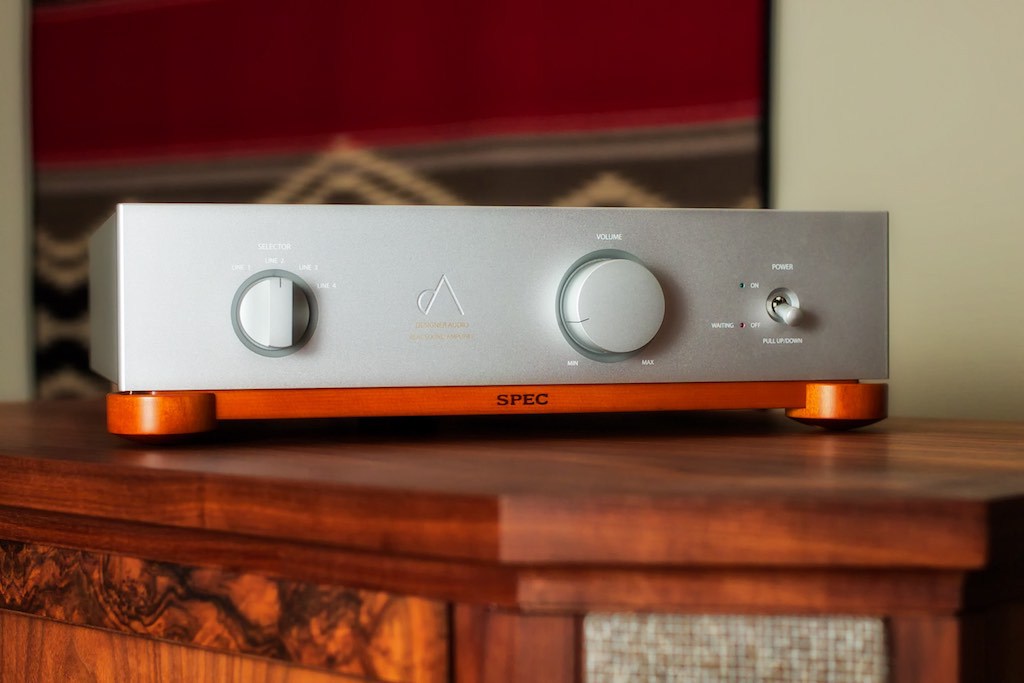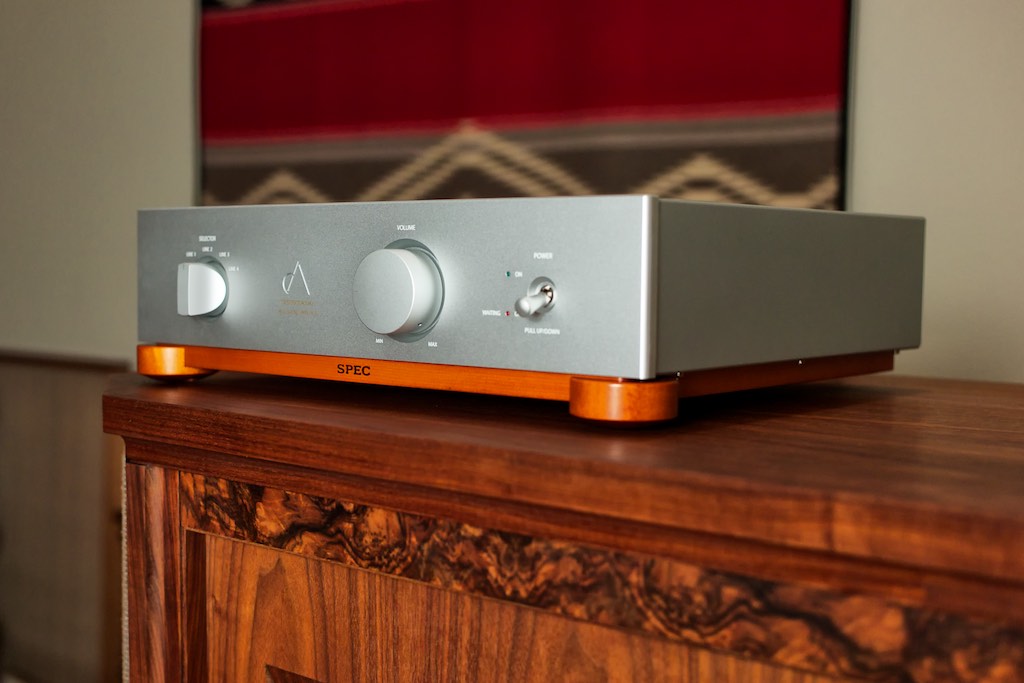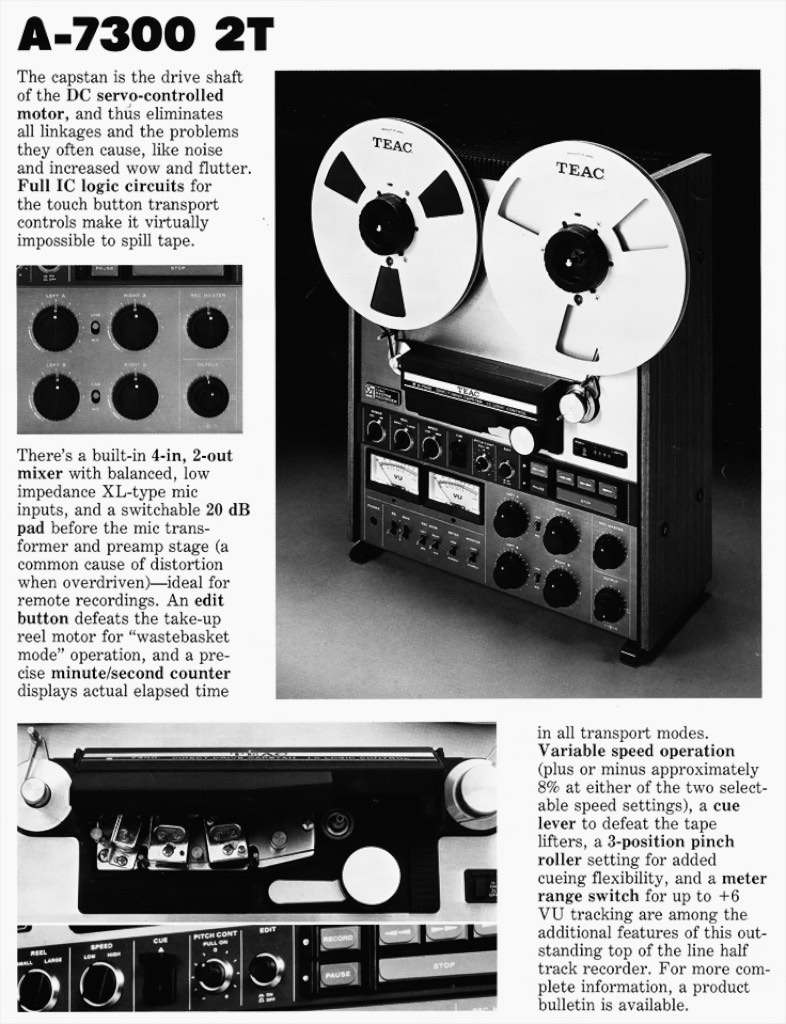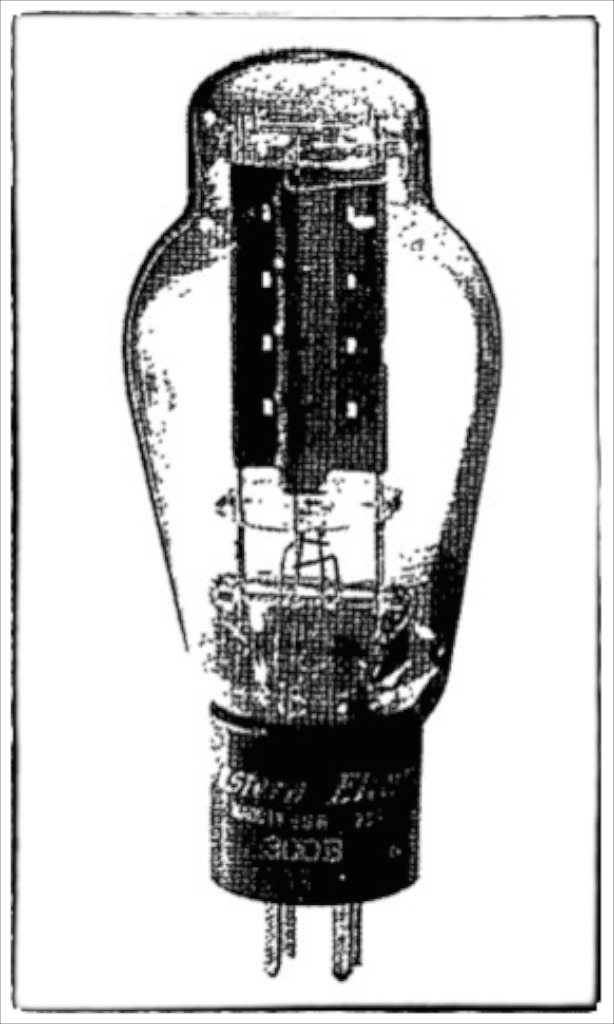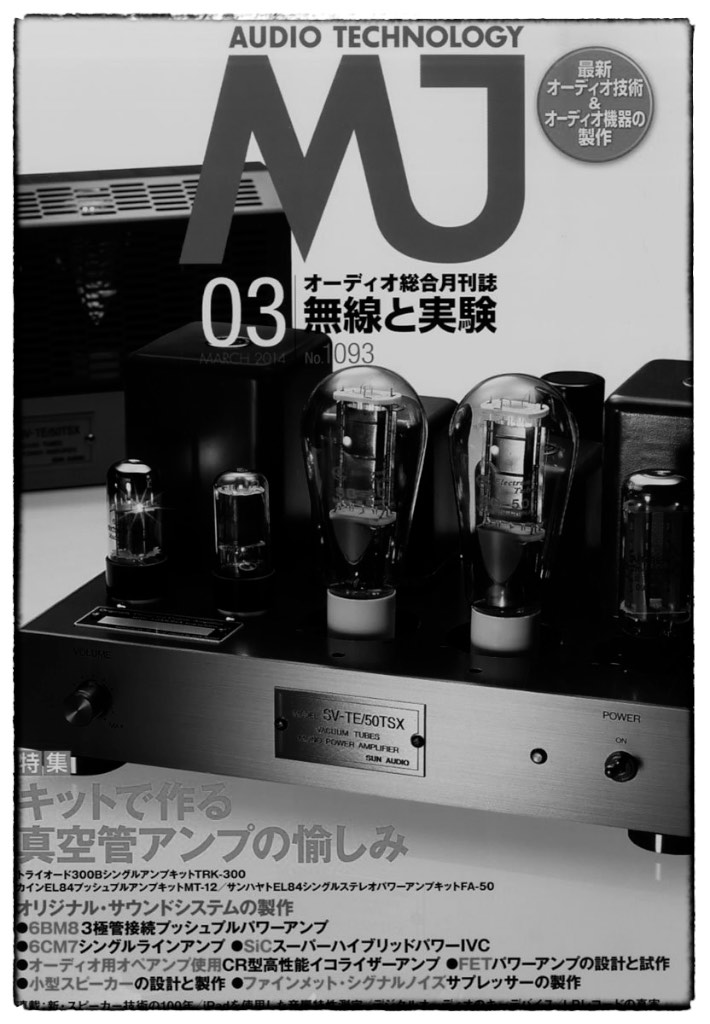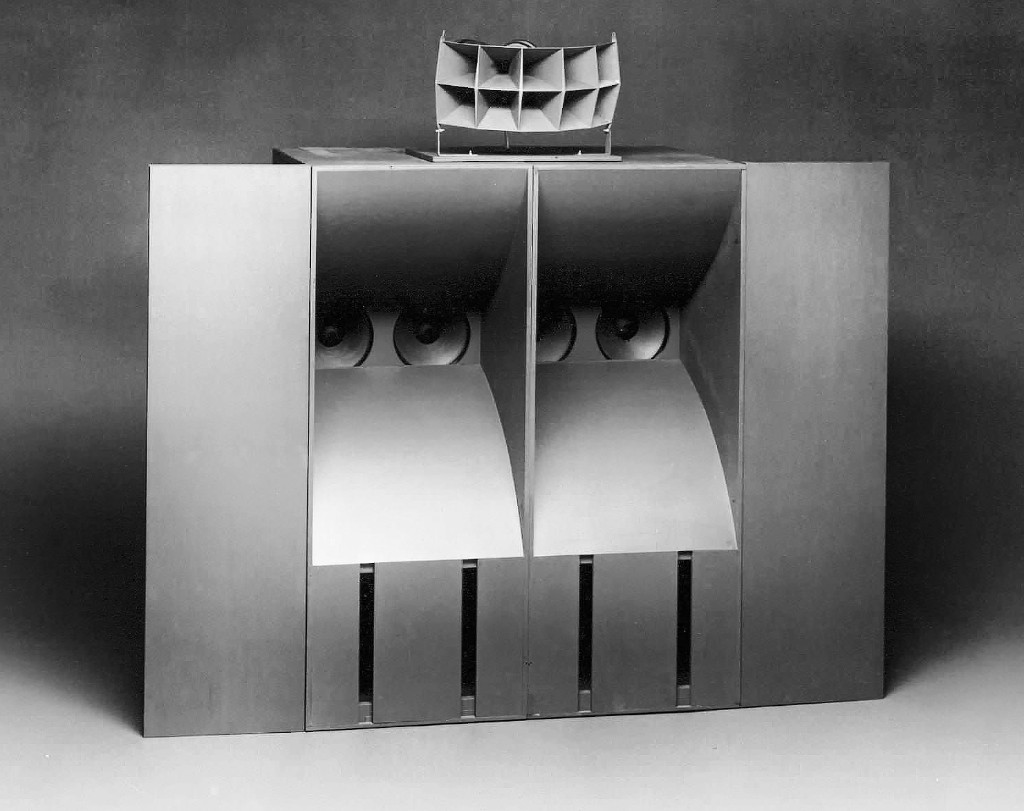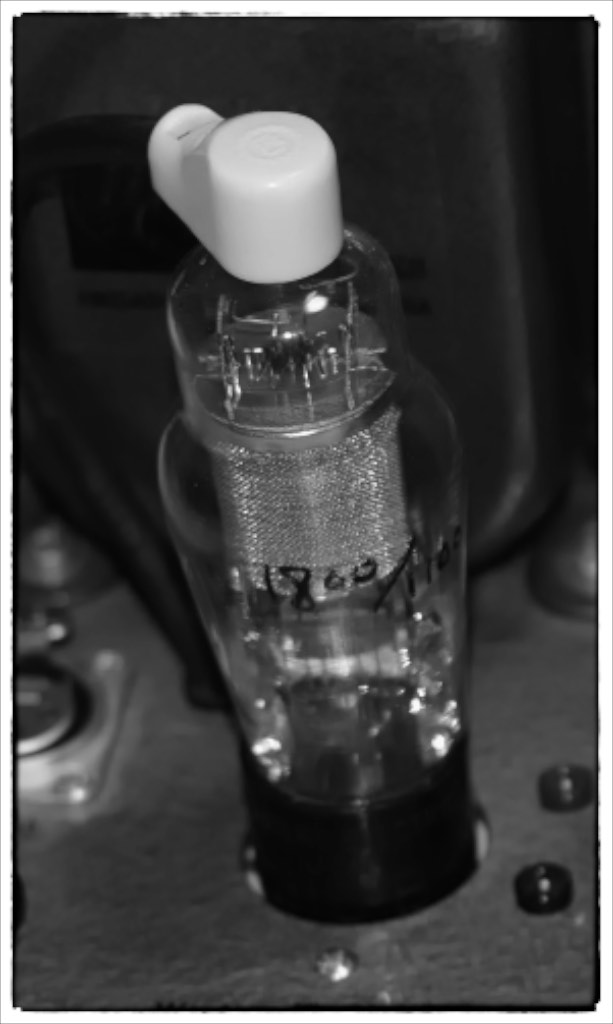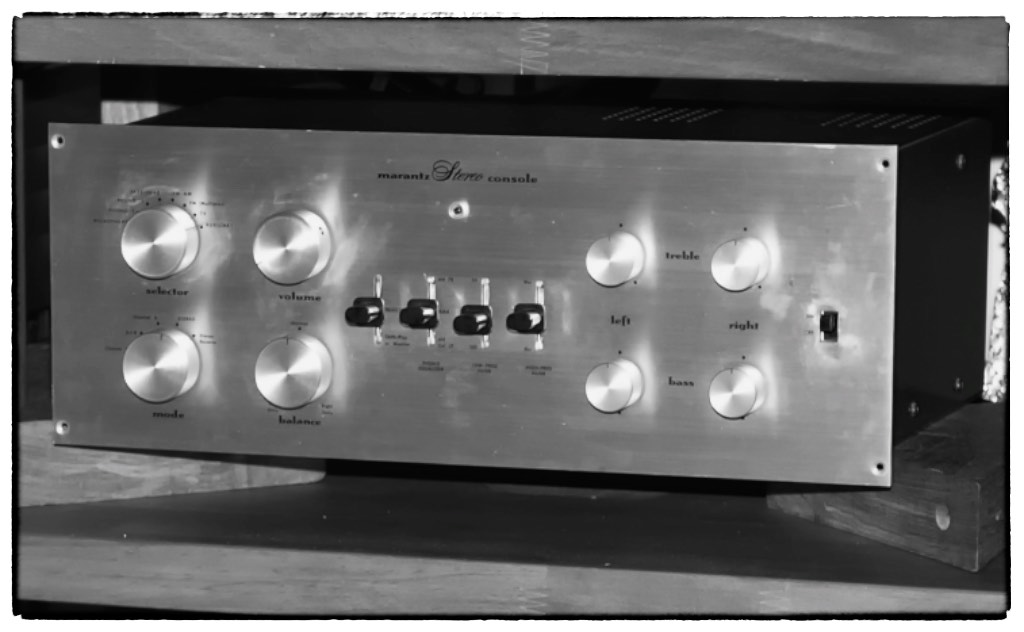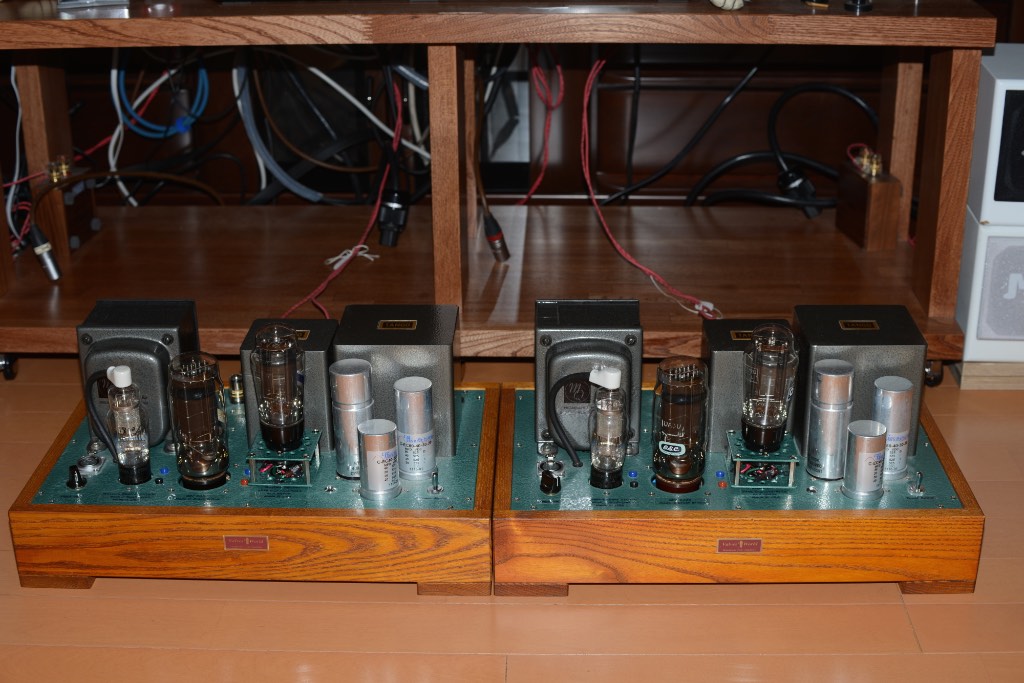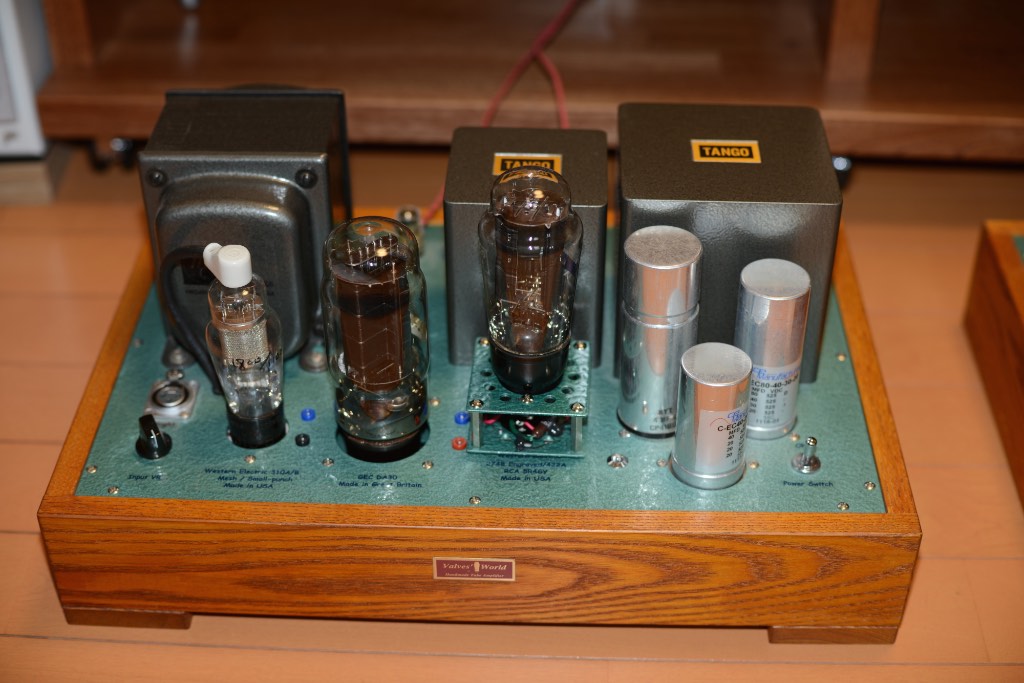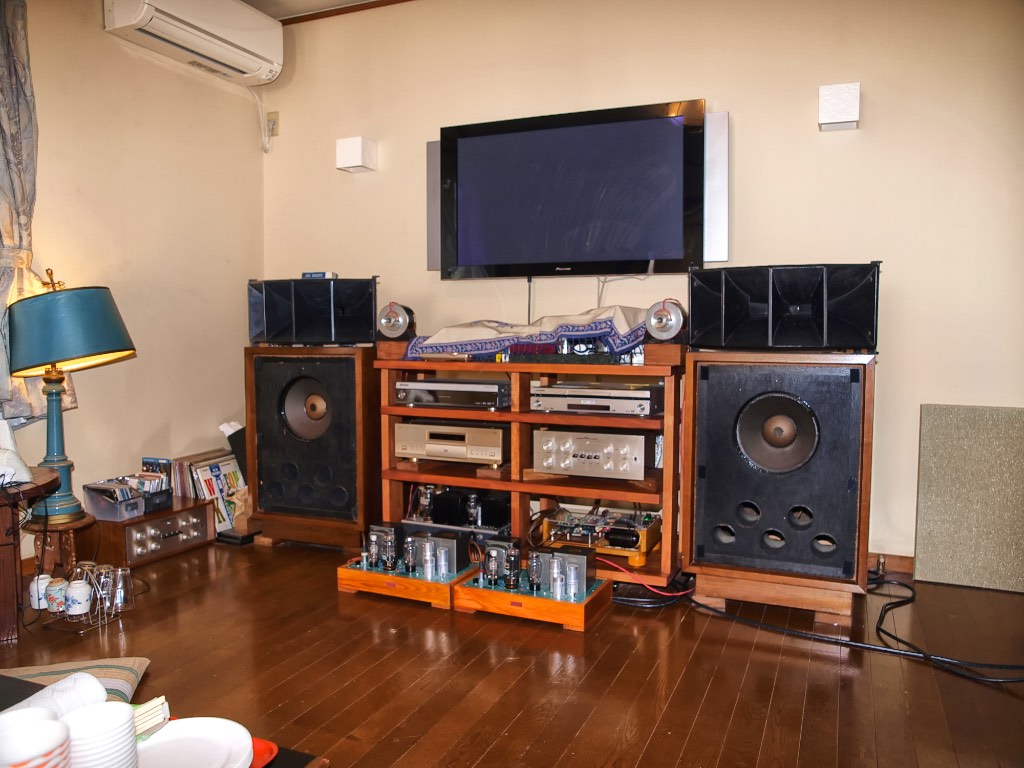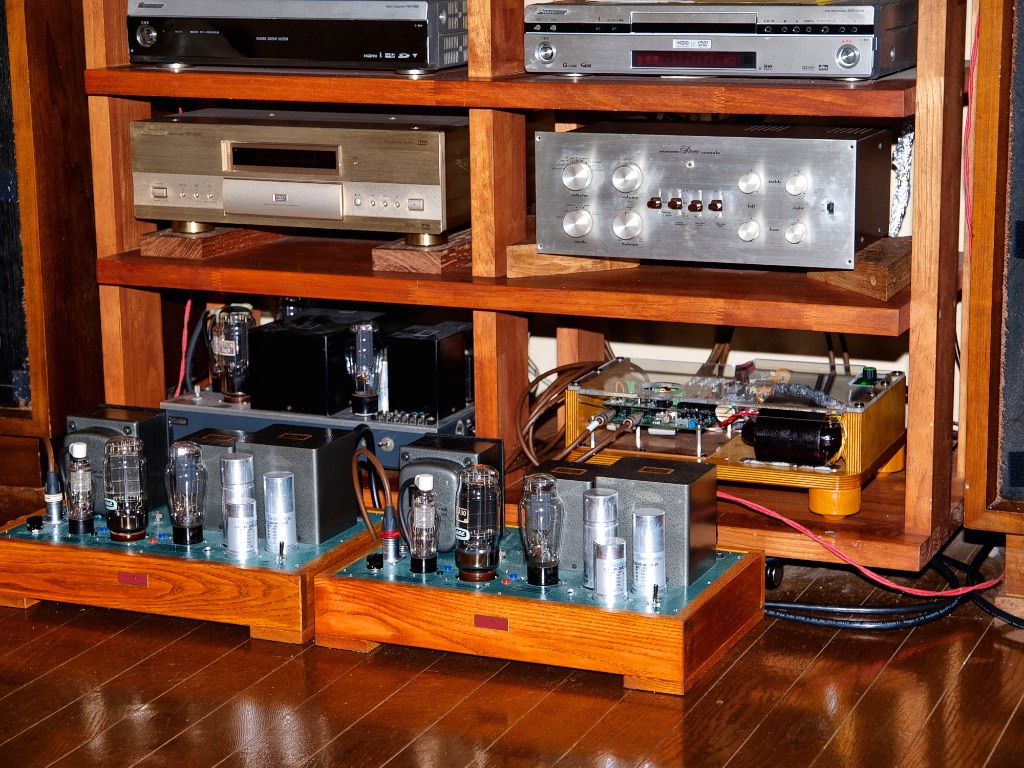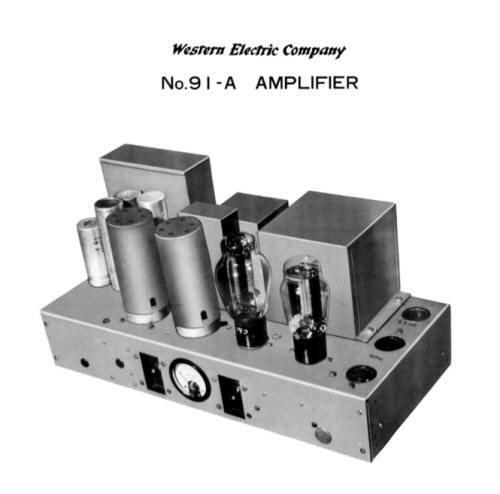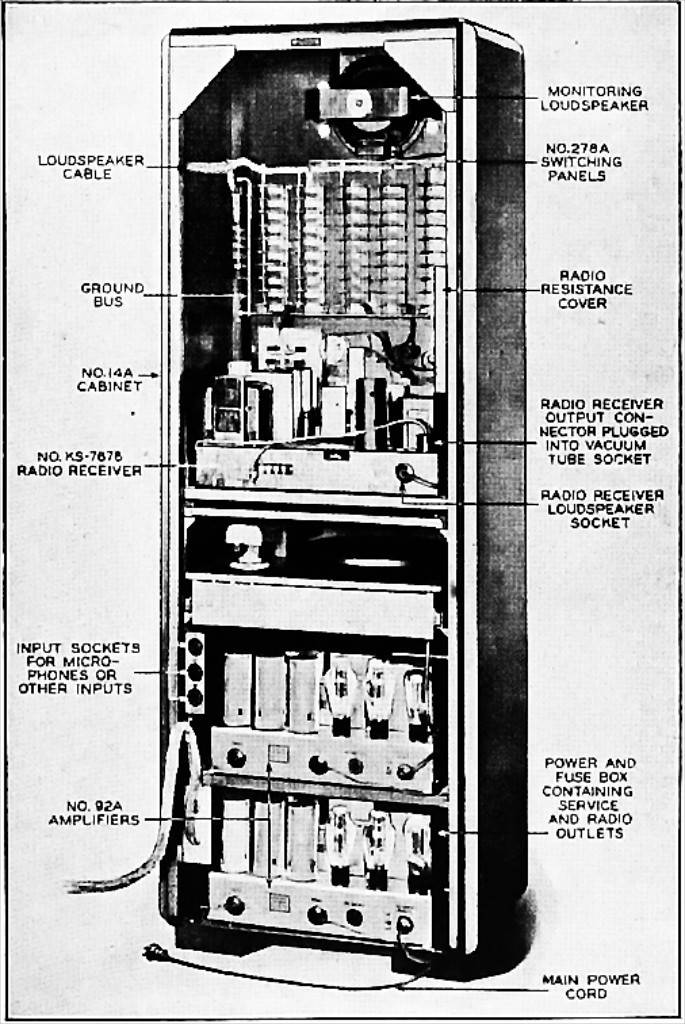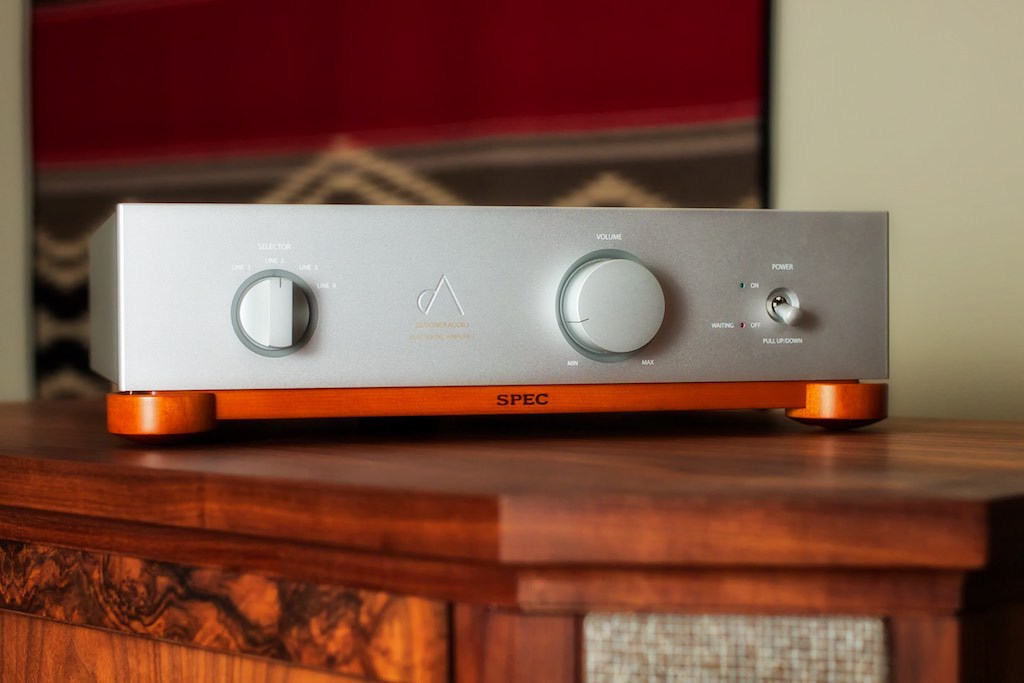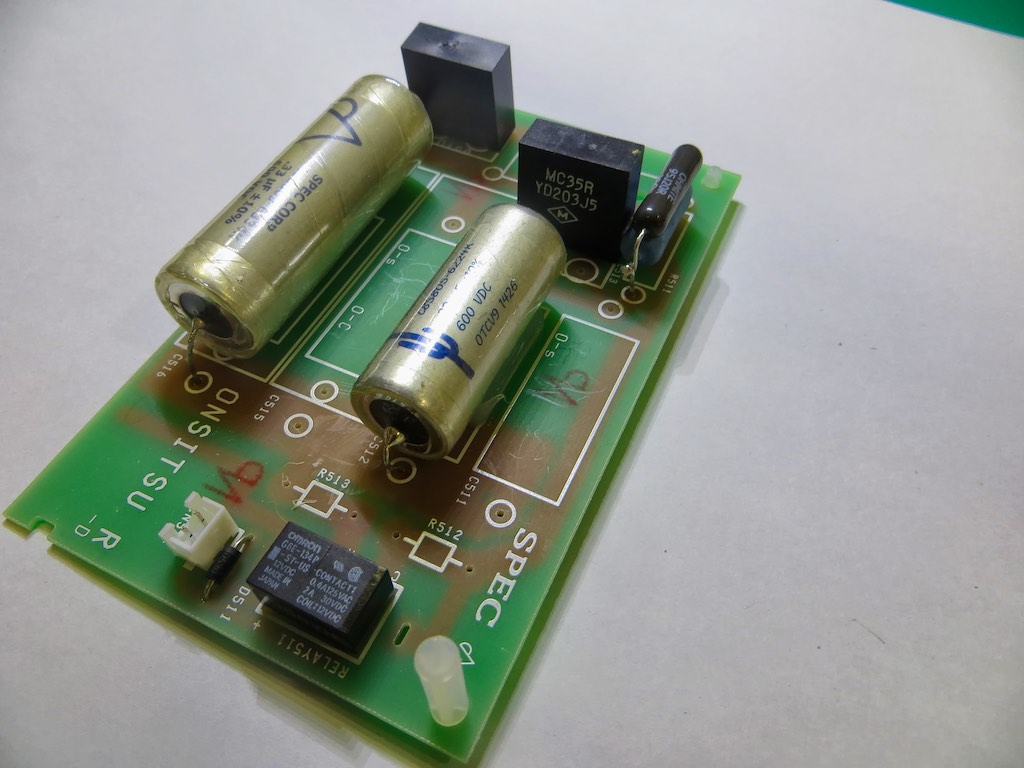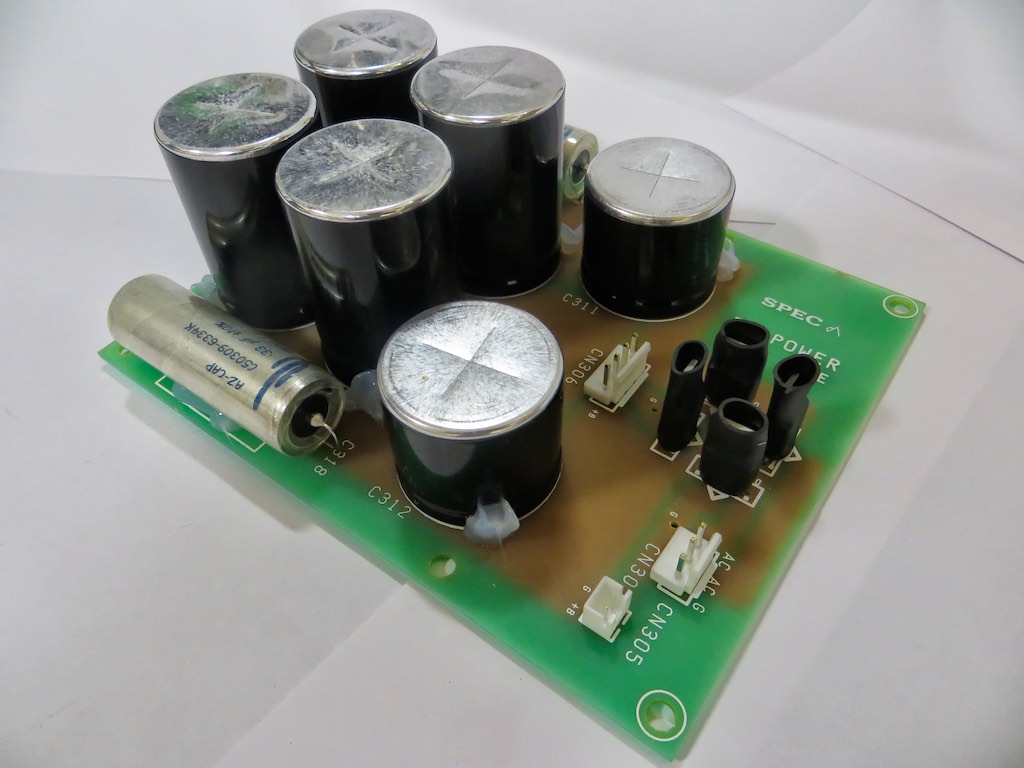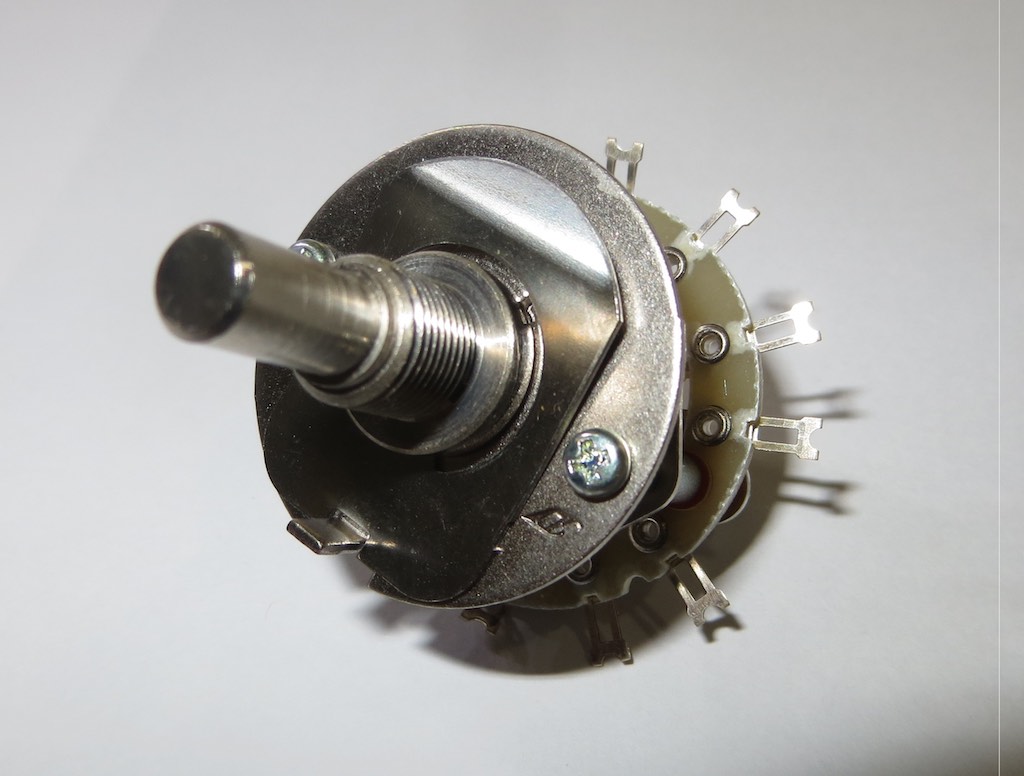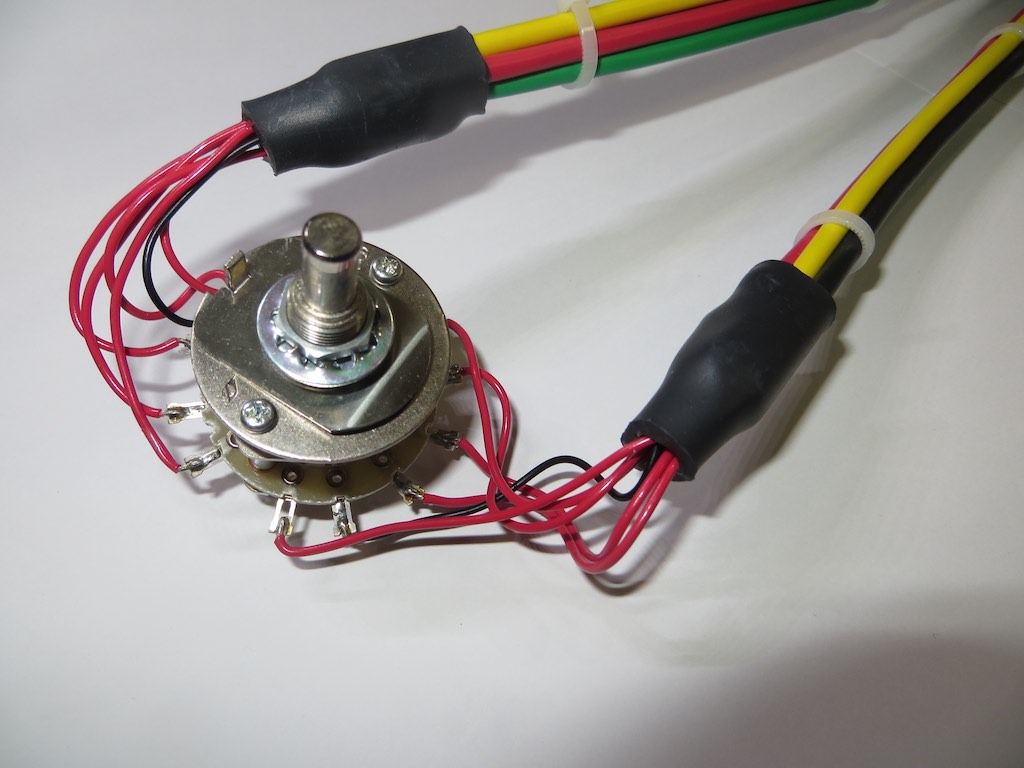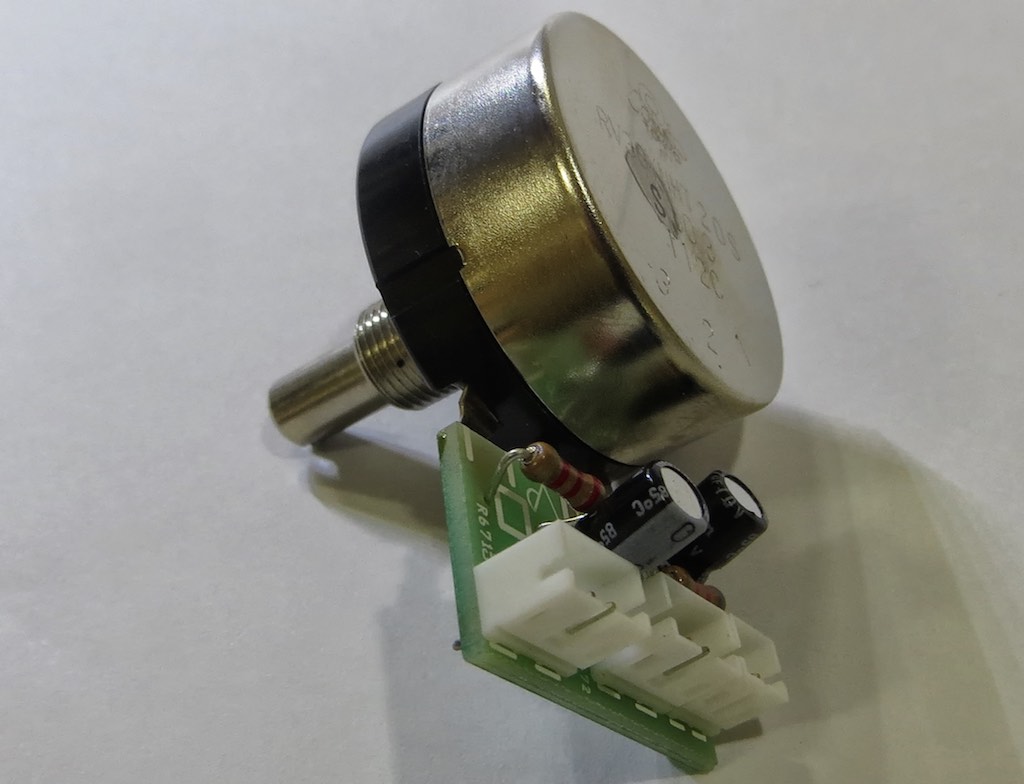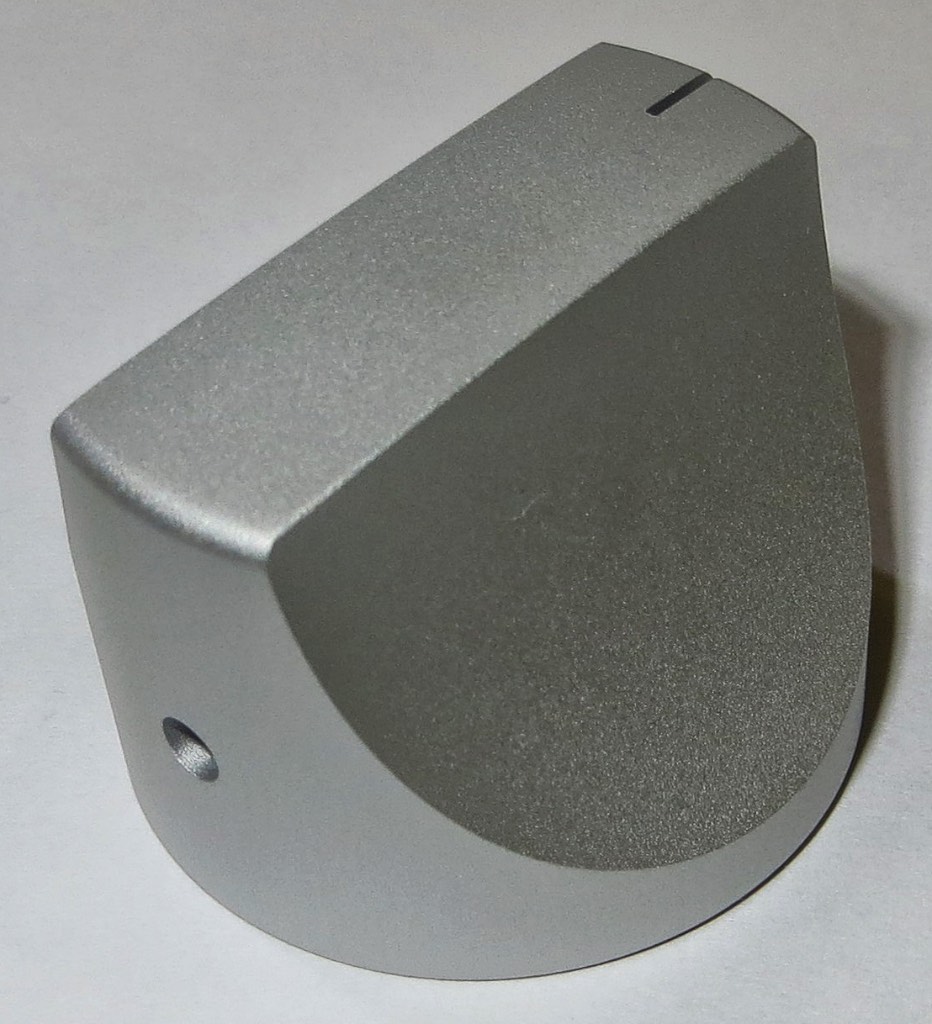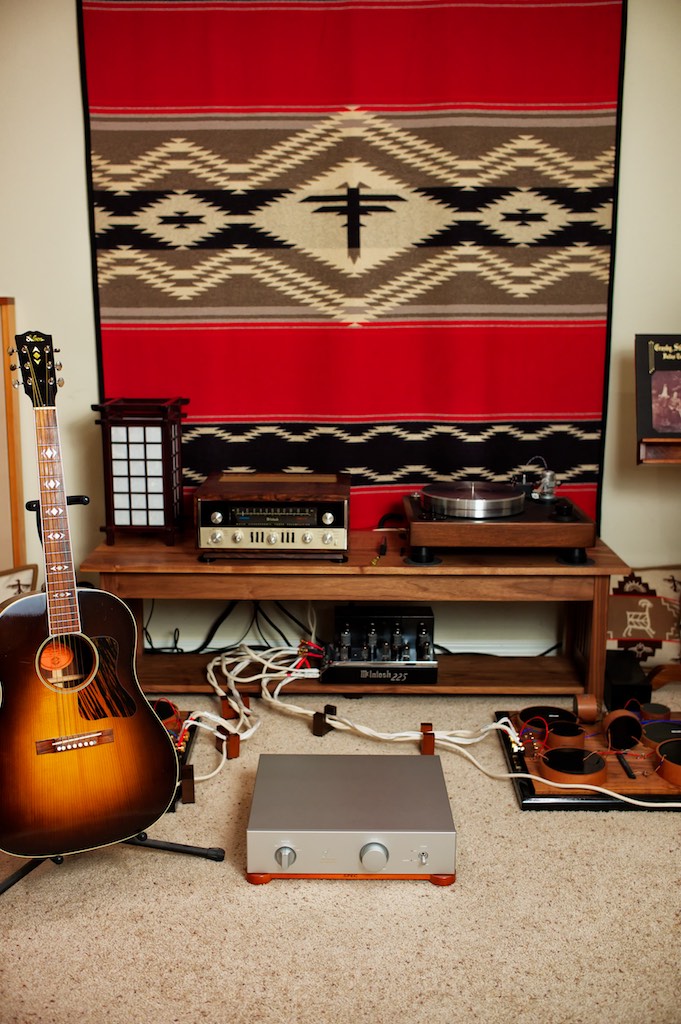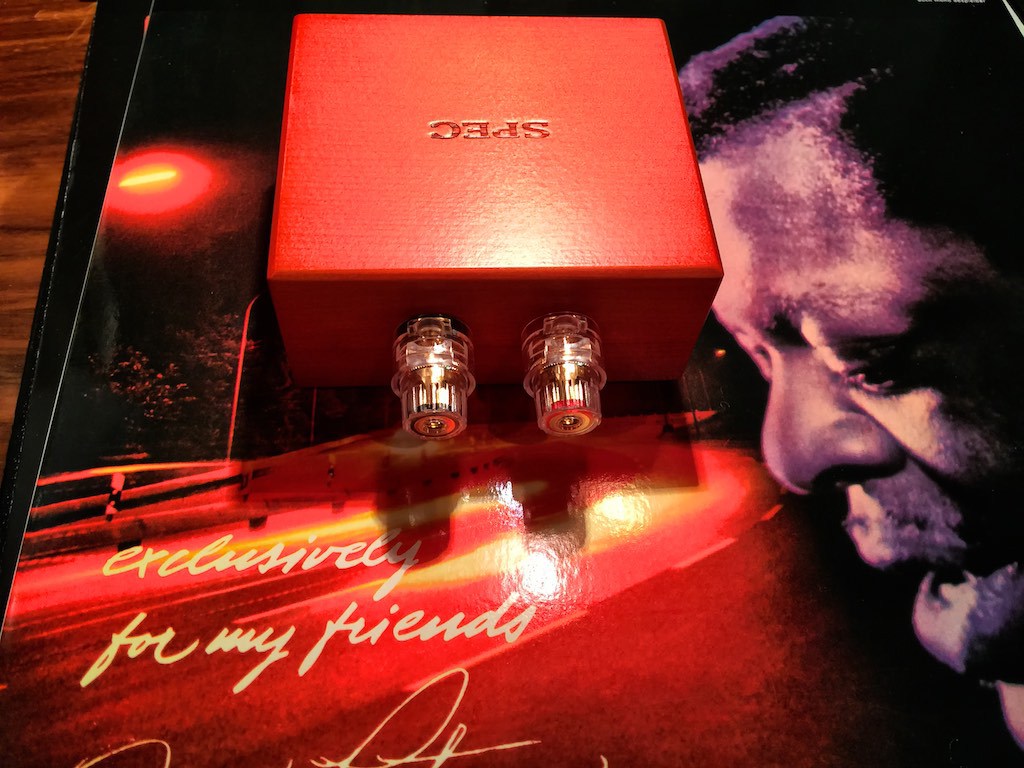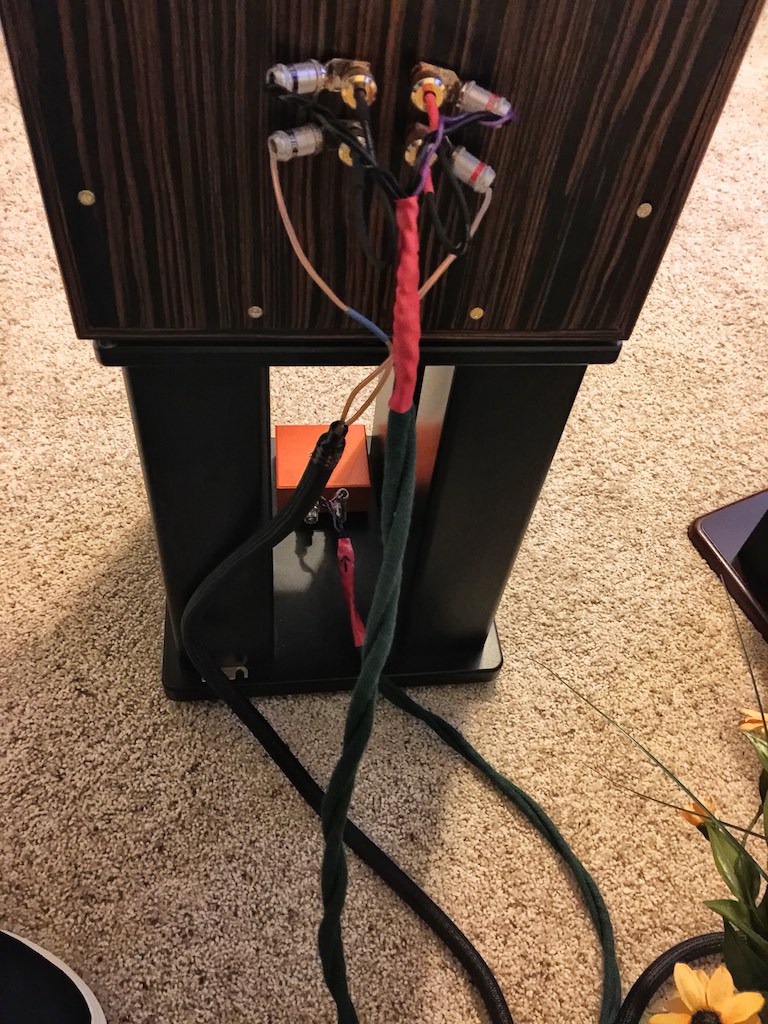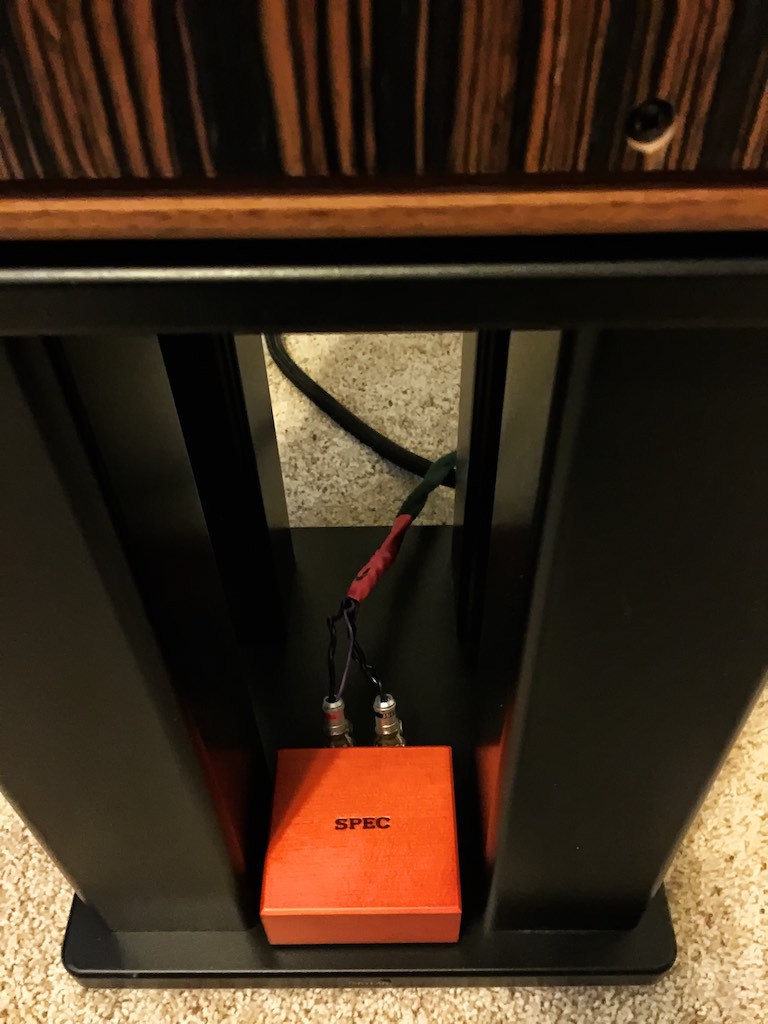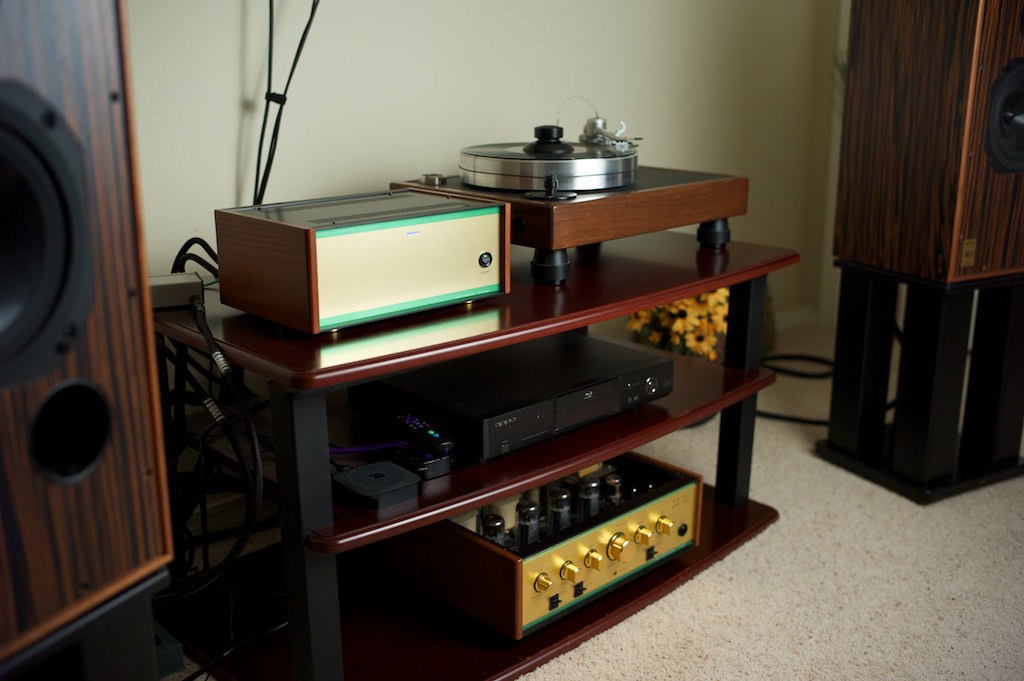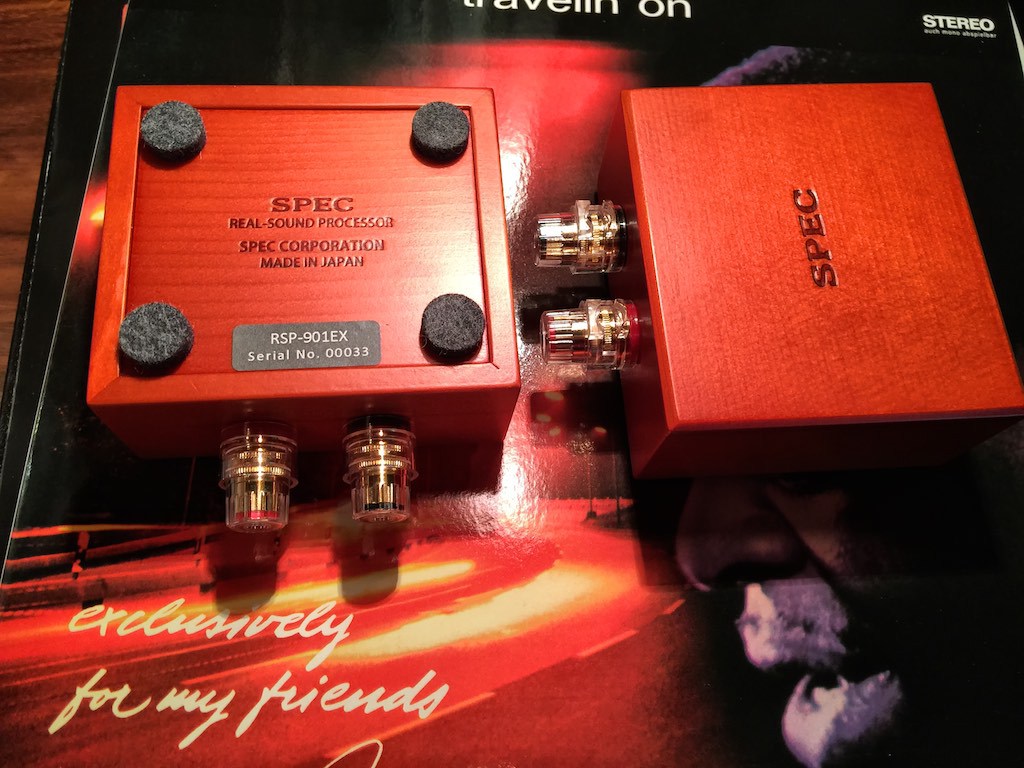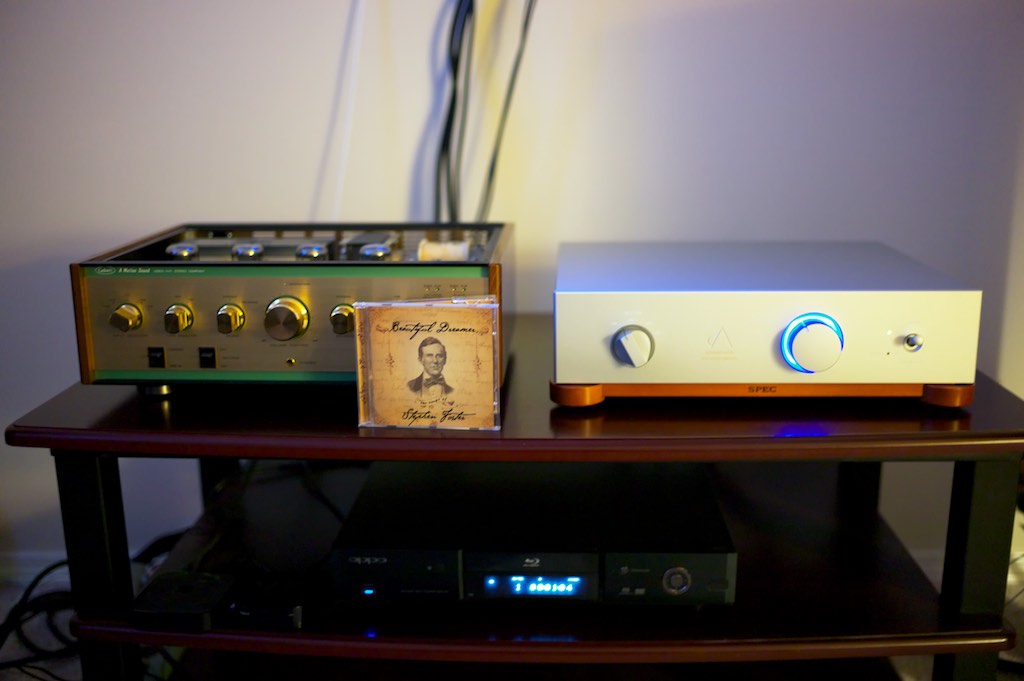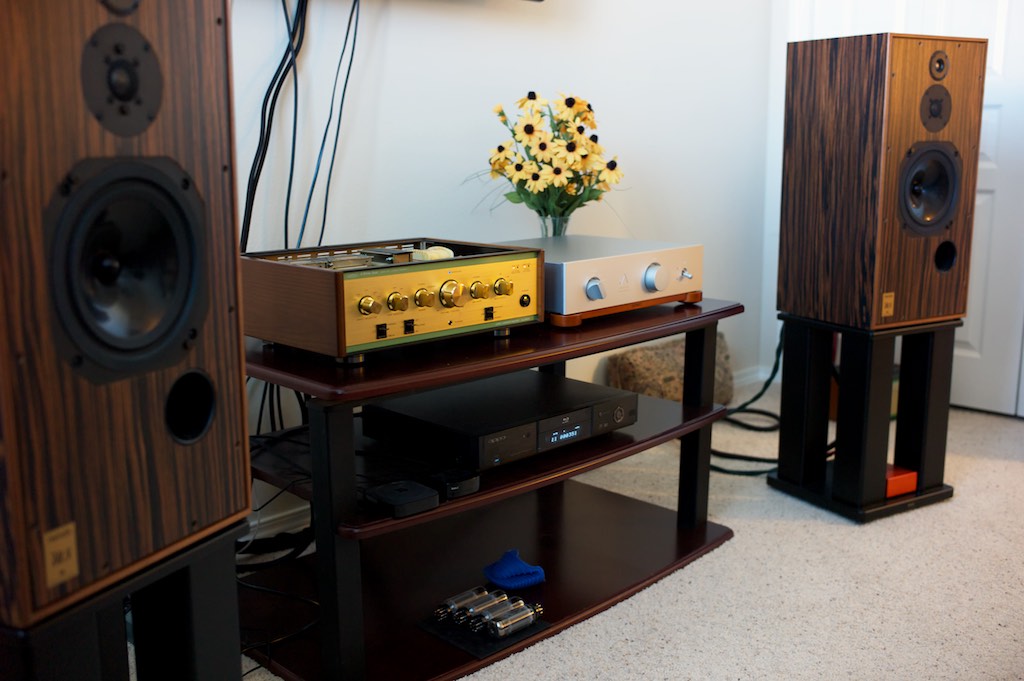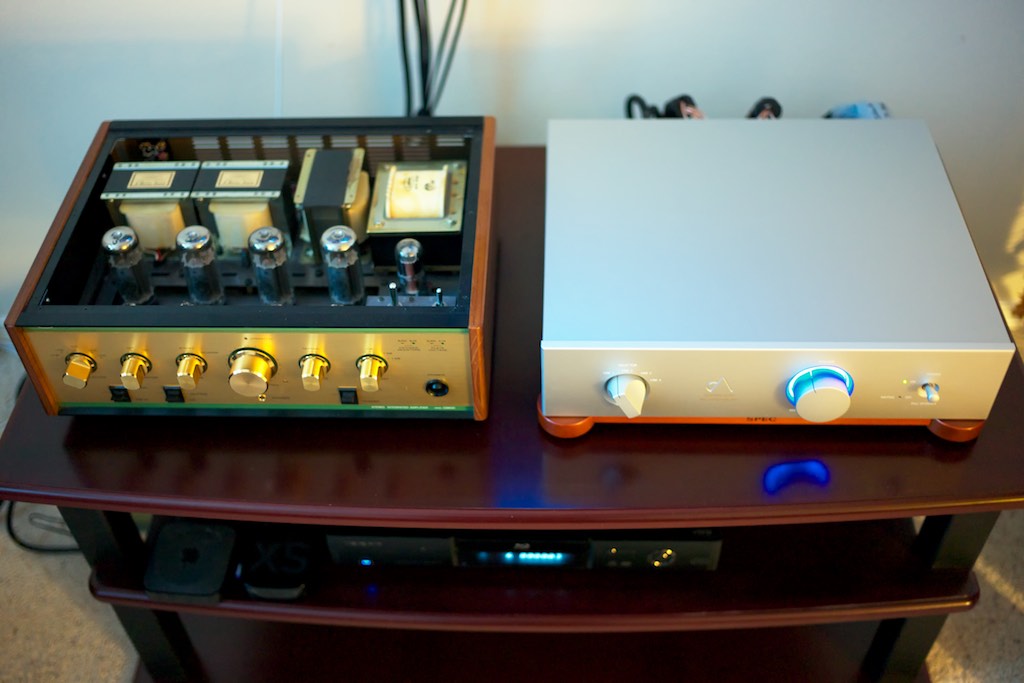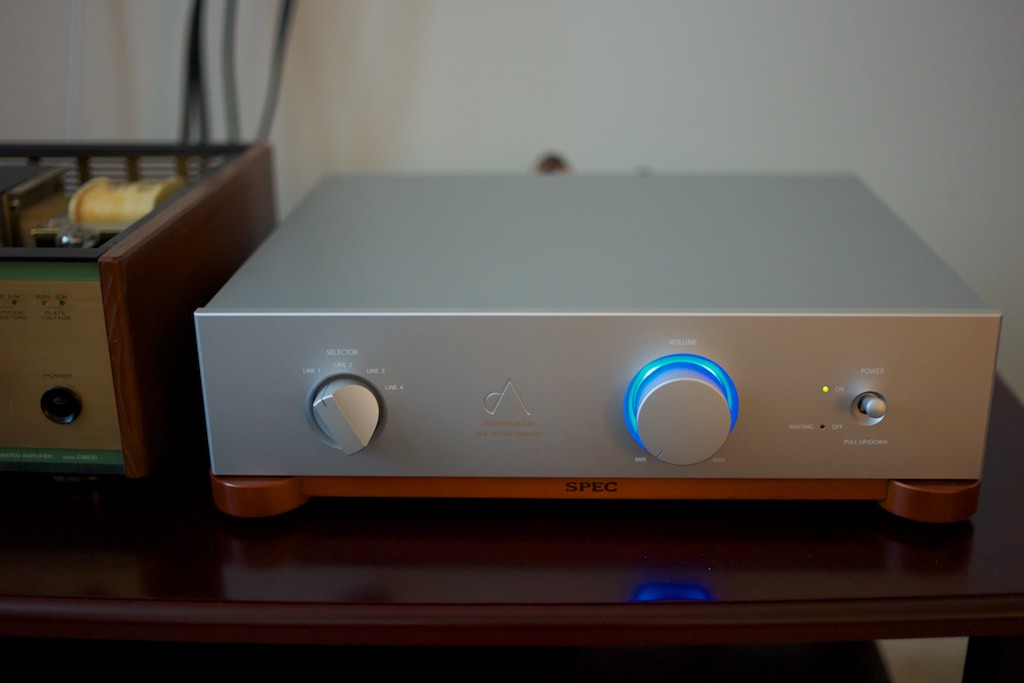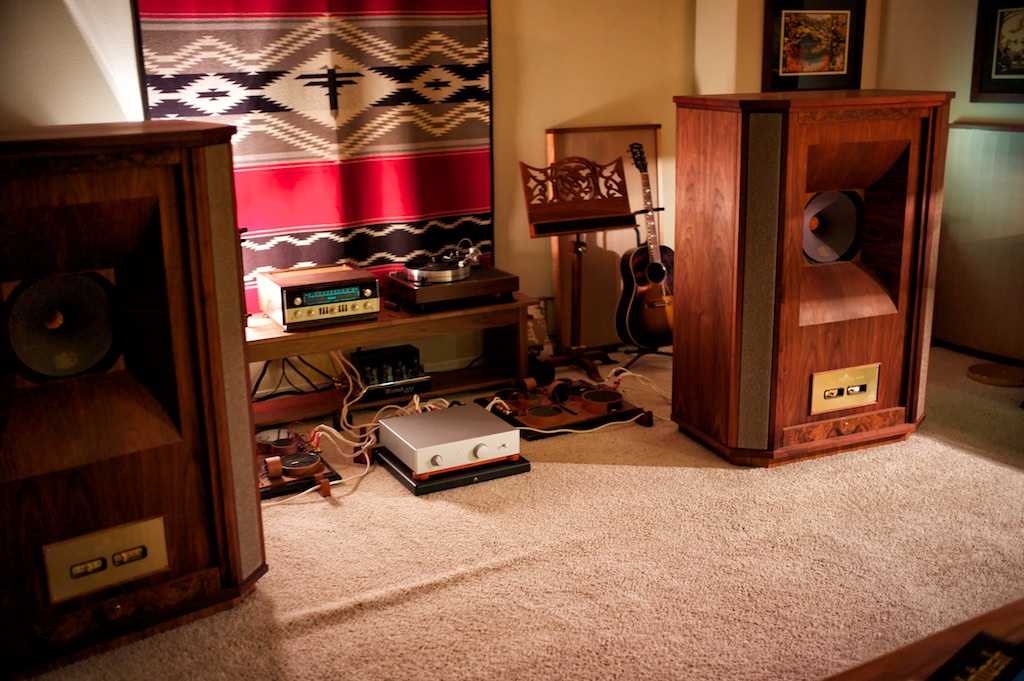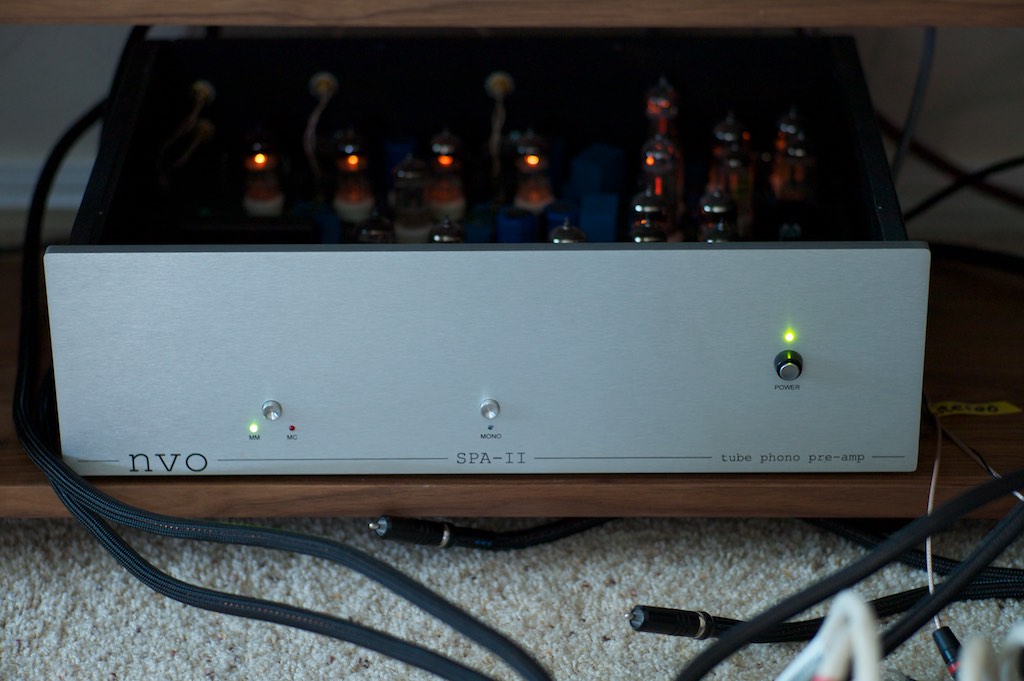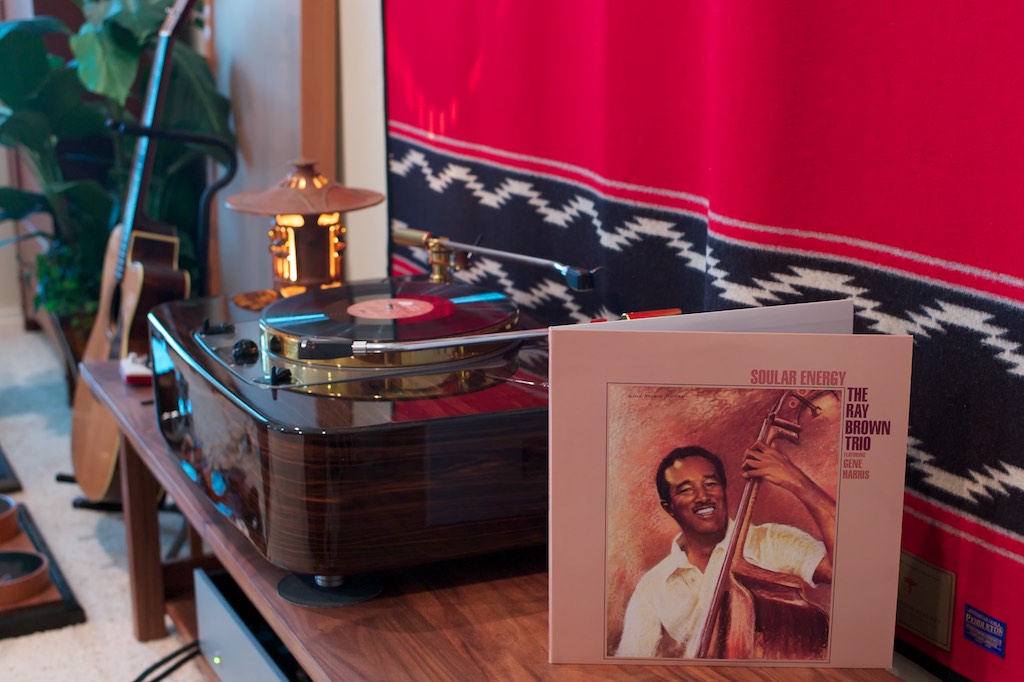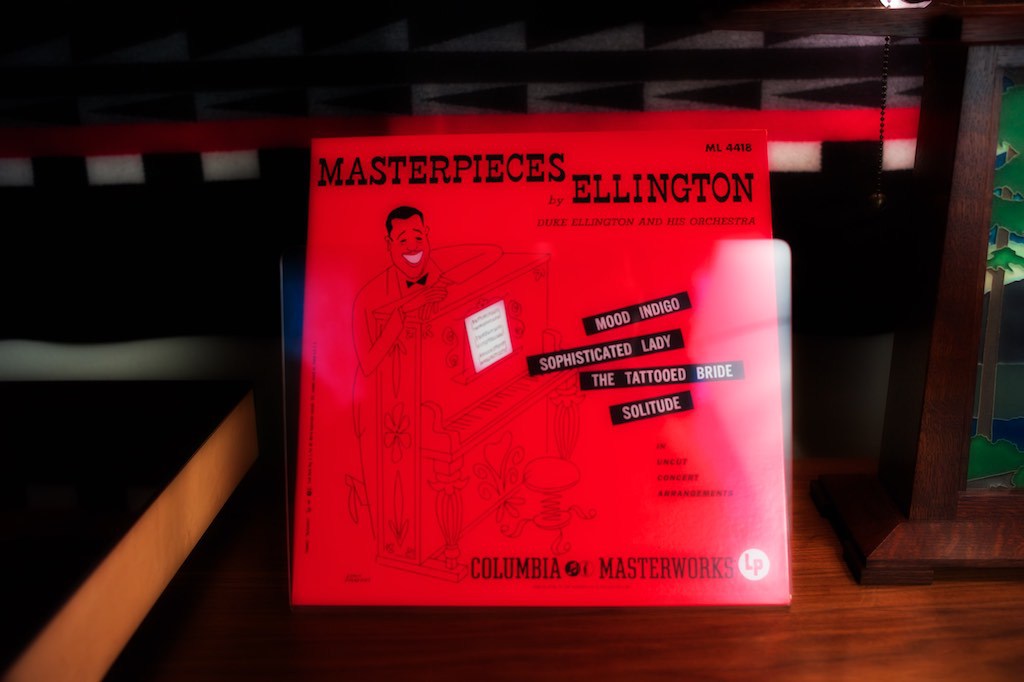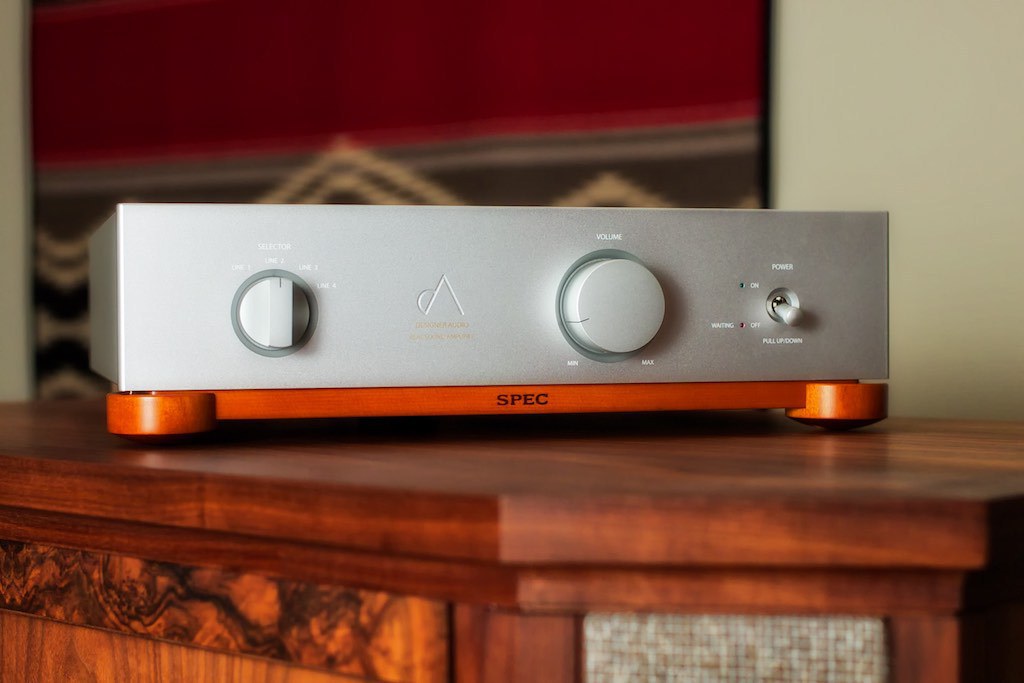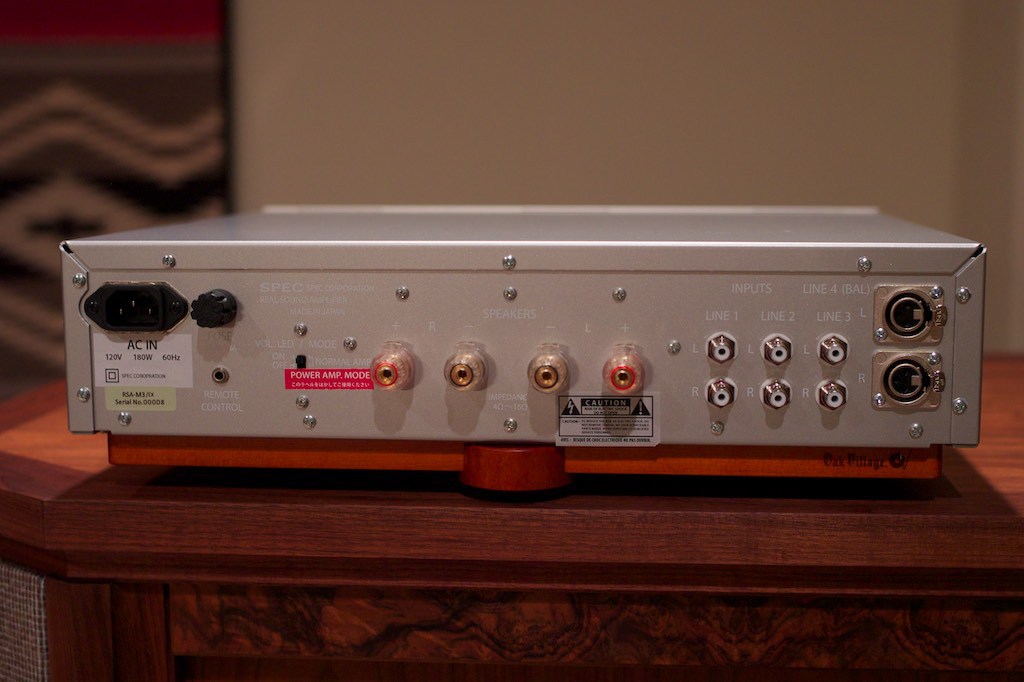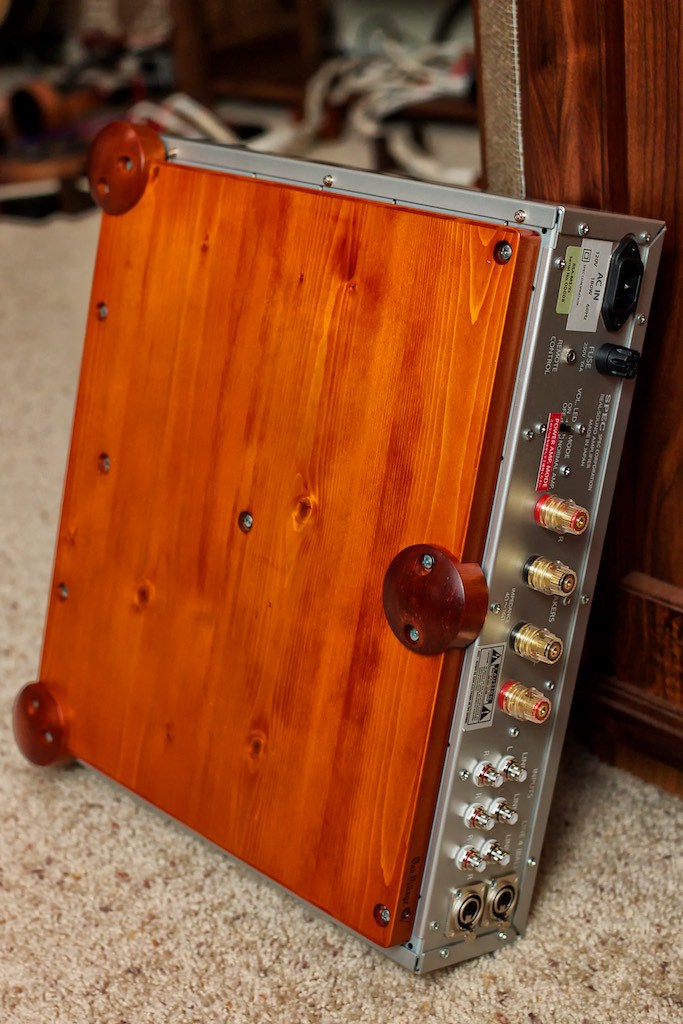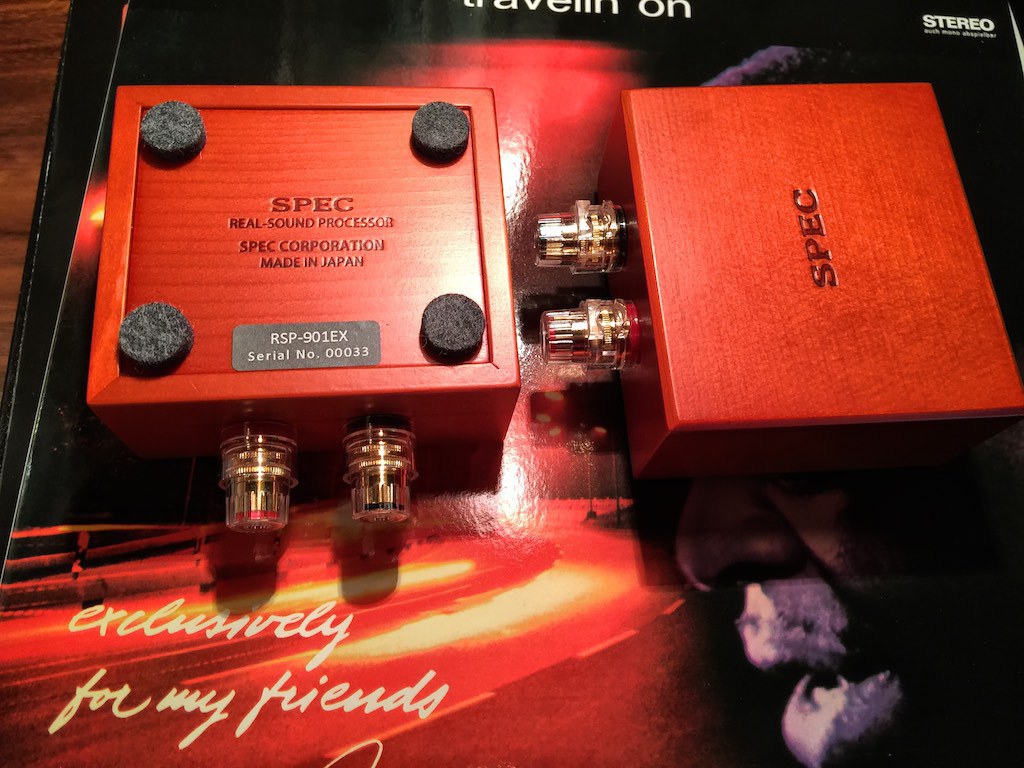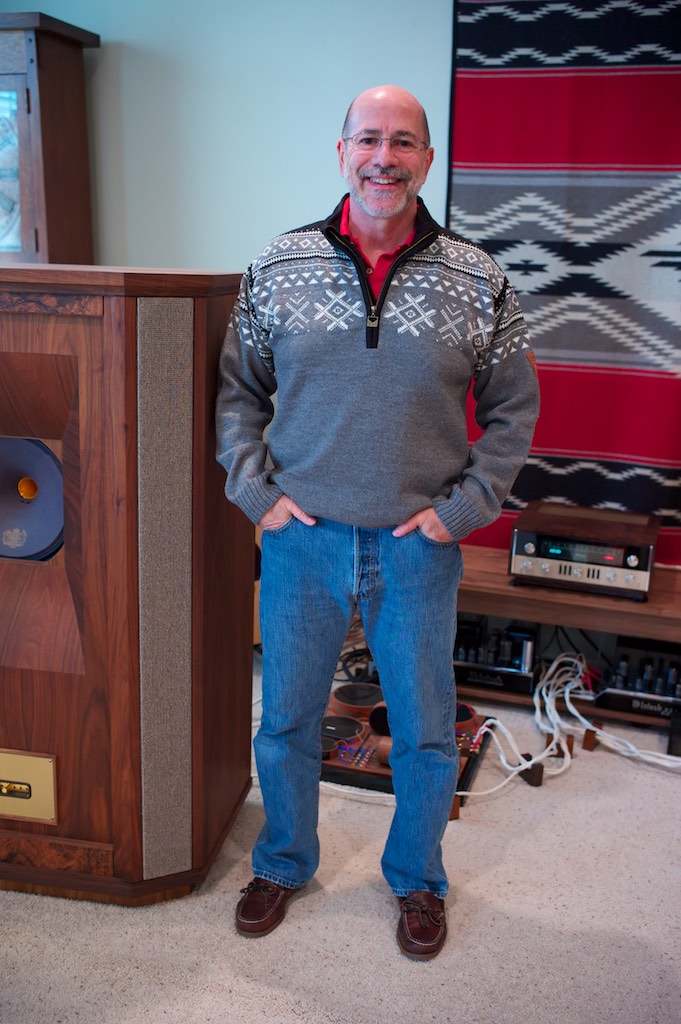The SPEC RSA-M3 EX Real Sound Amplifier from Japan
By Jeff Day
Most regular readers of Positive Feedback Online know of my long-time passion for vacuum tube electronics. I’ve enjoyed the musical prowess and sonic chops of contemporary artisan-designed single-ended amplifiers with various output tubes, like the EL84, 45, 2A3, 300B, F2a, and 845 output valves; as well as inspired push-pull amplifiers using KT88, EL84, KT66, EL34, KT90 outputs, and probably some others I’m forgetting at the moment.
Lately I’ve been reveling in the musicality of vintage audio electronics with their classic circuits, like the McIntosh MX110Z tuner/preamplifier (27 vacuum tubes!), the McIntosh MC240 stereo and MC30 monaural amplifiers (6L6GC outputs), and McIntosh MC225 stereo amplifier (7591 outputs). Célébrer le tube à vide!
However, when I reviewed the ASR Emitter II Exclusive Version Blue solid-state amplifier from Germany back in Issue 66 I found out that valves weren’t the only path to sonic nirvana, and that ‘Big Blue’s’ sonics & musicality were superb on my equally big Duelund-crossover’d customized Tannoy Westminster Royal SE loudspeakers.
I learned the audio lesson that while parts choice does make an important difference in performance, it is the ‘enlightened ear’ of the talented designer that determines the ultimate musical performance of an audio amplifier, whether it contains vacuum tubes or solid-state devices.
The High-Fidelity Adventures of Mr. Shirokazu Yazaki
A case in point is the SPEC RSA-M3 EX Real Sound Amplifier from the ‘enlightened ear’ of Mr. Shirokazu Yazaki in Tokyo, Japan, that sounds shockingly good by any musical or sonic measure.
From the first moment that I saw, touched, and powered my hi-fi systems with Yazaki-san’s SPEC RSA-M3 EX Real Sound Amplifier I was deeply impressed with what he has accomplished. There is a certain irresistible ‘sensuality’ sonically, musically, and even visually to the SPEC RSA-M3 EX Real Sound Amplifier that makes it quite a captivating amplifier to listen to music with.
Before I get too carried away telling you about the SPEC RSA-M3 EX Real Sound Amplifier, let me back up for just a moment and tell you about the man behind it, Mr. Shirokazu Yazaki (second from the left in the photo below). I have found the story of Mr. Shirokazu Yazaki’s audio journey during our conversations to be quite fascinating, and I’m hoping I can relay that sense of intrigue to you, and why I think his story is important.
First of all, Mr. Shirokazu Yazaki has been a successful professional audio designer in Japan for over 40 years, and has been involved in the design of many fine audio components from some of the foremost Japanese electronics companies during that time. Yazaki-san fondly reminisces about a few component design high points he was involved with, like the TEAC A-7300 semi-professional open-reel tape recorder while he was at TEAC, or the Pioneer CT-95 / T-1100S cassette recorder as a design team leader & manager at Pioneer in their cassette recorder engineering department, or the Pioneer DV-AX10 universal disc player as the general manager for the Pioneer DVD engineering department.
Those of you with a detailed historical knowledge of audio will remember the highly regarded TEAC A-7300 reel-to-reel; the Pioneer CT-95 / T-1100S cassette recorder, which was considered superior to even the legendary Nakamichi Dragon; and the Pioneer DV-AX10, which was the world’s first true universal disc player capable of playing CD, SACD, DVD and DVD-A with both high audio & video fidelity.
Towards the end of his career at Pioneer, Mr. Shirokazu Yazaki was put in charge of the Pioneer research & development center, where he first came into contact with a prototype class-D switching amplifier in 2006.
Now Back To The Beginning
Ok let’s stop right here for a moment. Now we are going to journey back in time 40 years or so to 1971 when Mr. Shirokazu Yazaki first started his professional audio design career at TEAC, a young man fresh out of the university with a mechanical engineering degree.
There were events occurring during that time that would mark it as one of the defining periods of audio history, which would send ripples of inspiration through time to the future to spark an audio revolution that changed the way that many of us today think about what’s possible in high-performance audio.
Over the years as an audio writer, it has been a great pleasure for me to interview a number of eyewitnesses who were involved from the beginning of that important period, like Mr. Shirokazu Yazaki, and to tell the story of how events unfolded, and how those events would come to shape the future of enthusiast audio, including my own enjoyment of music today.
While Japanese audio enthusiasts were familiar with the excellent American vacuum tubes from Western Electric, RCA, GE, etc., they didn’t have a lot of access to European and British vacuum tubes until towards the end of 1960s, when a most important event occurred with French audio connoisseur Jean Hiraga (of L’Audiophile fame) starting to import European & UK vacuum tubes to Kobe, Japan.
Magazines like MJ and Radio Engineering were publishing do-it-yourself (DIY) articles about building vacuum tube amplifiers, including some using those ‘new’ European & UK vacuum tubes from Jean Hiraga, which were embraced by the creative ‘underground’ audio movement in Japan. There were a lot of really interesting designs taking shape around the vacuum tubes that were available from America, Europe, and the UK, and in particular around the ascension of directly heated single-ended-triode power (SET) amplifiers that were intended for use with high-sensitivity horn loudspeakers.
The Tokyo Audio Fair of 1971 featured a number of those vacuum tube amplifier designs, and notably the combination of DH-SET amplifiers driving high-sensitivity Altec A-5 loudspeakers, which wowed show goers with their superlative music-making ability, including our young Mr. Shirokazu Yazaki who had just started his career at TEAC.
Now the young Mr. Shirokazu Yazaki who went to work at TEAC was also an audio enthusiast & music lover who particularly enjoyed listening to jazz, so in 1971 when Yazaki-san went to the Tokyo Audio Fair he was impressed by the intense musical satisfaction that could be realized by listening to music with DH-SET amplifiers powering high-sensitivity Altec horn loudspeakers.
Excited by the possibilities of that 1971 Tokyo Audio Fair, Mr. Shirokazu Yazaki embarked upon what would become a life-long journey of assembling & refining his personal high-fidelity music system, first by constructing his own DH-SET amplifier, then by building and customizing a Marantz 7 kit preamplifier, and over time developing his Altec & Onken-based horn loudspeakers.
In 1972 Yazaki-san began building his own SET amplifier after reading an article in the June issue of MJ magazine by a Mr. Anzai about building a simple GEC DA30 SET amplifier. Yazaki-san completed that first SET amplifier in early 1973, using the American Western Electric 310A as the driver, a Western Electric 274B as a rectifier, and the English GEC DA30 as outputs (the DA30 is less well known in the West, than say the 300B is, but it is held in extremely high regard by aficionados within the Japanese DH-SET scene, but they are rare and difficult to come by these days).
Mr. Shirokazu Yazaki told me that he has continuously improved his DA30 DH-SET stereo amplifier over the years, and the combination of Western Electric 310A driver, Western Electric 274B rectifier, and GEC DA30 outputs provides the most beautiful tonality he has every heard from an amplifier. Even though they were both capable of putting out 8-9 watts, Yazaki-san told me he selected the GEC DA30 over the Western Electric 300B for his amplifier because it had superior high-frequency response. He also went on to say that the oldest version of the Western Electric 310A, the ‘mesh shield’ that was produced in the 1930s & 1940s, was critical to getting the best sound. He thought that later versions of the WE 310As sounded rougher & less natural compared to the smooth & natural sounding original ‘mesh shield’ version. Yazaki-san also told me that the 1940s ‘engraved’ version of the Western Electric 274B rectifier expressed tonal colors better than all the other rectifiers he had experimented with. Compared to the ‘engraved’ version of the 1940s WE 274B rectifier, he found the Telefunken GZ34, Philips original GZ34, Mullard GZ37, GZ37 big bottle, RCA5R4GY, Western Electric 422A, etc., while excellent rectifiers, all bleached the tonal color to some extent.
The Western Electric 310A driver, Western Electric 274B rectifier, and the GEC DA30 outputs resulted in a rich midrange, beautiful tone, and a powerful upper bass that combined to give exceptional musicality.
Shortly after completing his DA30 DH-SET stereo amplifier Mr. Shirokazu Yazaki began building up his horn loudspeaker system. He started his loudspeaker system with a pair of 1960s vintage Alnico-magnet Altec 414A woofers in 1973, and then ordered Mr. Koizumi’s Onken OS-NEW500MT drivers with matching SC-500WOOD wood horns in December of 1973, which were delivered in 1975. In 1977 Yazaki-san added Onken OS-5000T Esprit tweeter to complete his horn loudspeakers.
In 1979 when Marantz released the Marantz 7 in kit form, Yazaki-san bought the kit and built it up with better parts. Yazaki-san said he learned a lot about getting good tone modifying his Marantz 7 kit with different components, and he has made continuous improvements to it to the present day.
Mr. Shirokazu Yazaki described to me the sound of the audio system he built as being transparent, beautiful, rich, and dynamic, but most importantly it possessed “real stereoscopic sound full of musicality.”
A Quick Lesson in Big DH-SET History
Now let me diverge slightly from Mr. Shirokazu Yazaki’s story for just a moment so I can connect the dots of audio’s ‘big DH-SET history’ for you by telling you how the Japanese DH-SET audio culture and Jean Hiraga’s importing vacuum tubes to Japan would eventually trigger a change in Western audio culture, and then we’ll get back to Mr. Shirokazu Yazaki’s story and I’ll explain how it all connects together.
Japanese audio enthusiasts like Mr. Yazaki-san who noticed how good DH-SET amplifiers were both musically & sonically started buying up vintage American & English vacuum tubes like the Western Electric 310A & 274B and GEC DA30, and vintage speakers that were designed to be used with low powered vacuum tube amplifiers (like the Tannoy series of Dual Concentric™ speakers and enclosures, and the Altec Voice of the Theatre loudspeakers (Altec was a spin off company of Western Electric incidentally)).
Those Japanese music lovers & fine audio constructeurs of vacuum tube circuits noticed how good those types of hi-fi equipment were at portraying the timbral & color aspects of the music, and like Mr. Shirokazu Yazaki, those enthusiasts continued to develop and refine those systems so that their presentation of music’s timbral and color elements were truly profound, and their listening emphasis was expressed through equipment choices that maximized those qualities to result in a very different presentation of music than many listeners in the West were used to at the time.
However, once a fire is lit, you really can’t keep it hidden for long, and word about the amazing musical realism attained by combining those highly refined DH-SET amplifiers with highly sensitive loudspeakers soon got out to those in the West who had ears to hear, like Jean Hiraga.
Due to his importing vacuum tubes to Japan, Monsieur Hiraga was among the first in the West to become aware of this new exotic DH-SET audio trend in Japan. He and his French enthusiast audio magazine L´Audiophile had discerned the importance of this aroma of music wafting in on the breeze from Japan and responded by opening a shop in Paris to do demonstrations of this new-old style of music listening.
In 1986 L´Audiophile demonstrated a 300B DH-SET amplifier at their store in France that signaled the birth of the DH-SET movement on French soil. The musical realism, the exquisite textures & colors, and the dynamic truths that L´Audiophile achieved so easily in their demonstrations using DH-SET amplifiers, Altec-Onken & Voice of the Theatre loudspeaker systems, and playing records on a Platine Verdier turntable, impressed a lot of people, and the SET, horns, and vinyl approach to musical nirvana started to go viral, working it’s way into Germany.
The founder of Auditorium 23 in Germany, Keith Aschenbrenner, told me that after hearing the L´Audiophile system during this period, he thought that what Philippe, Jean, and Gerard were doing was remarkable, and their demonstrations marked a major milestone in musical realism in audio. Keith told me, “It was quite an education to hear that new 300B SET approach to amplification. When we got that first 300B SET amplifier in our shop, connected it to the Voice of the Theatre loudspeakers, it was just like a musical Christmas present. In the beginning, we handled it like Sunday shoes. The harmonic integrity and musical realism were astonishing. We went from using it for special demonstrations only to using it every day. Going back to our other equipment became so hard that we just gave up on it and stayed with the 300B.”
A little while later the single-ended-triode virus made it to the North American audio scene when Noriyasu Komuru started building DH-SET amps, as did Gordon Rankin, and Don Garber. The DH-SET fires had begun burning in the consciousness of audio enthusiasts across North America, where whispers from the audio underground were heard to say “DH-SETs live again, and they can bring your music back to life.” The SET resurrection fires raged on through time and place to a point where most contemporary enthusiasts now consider the DH-SET amplifier to be a normal part of the Hi-Fi scene.
Now Back To The Future
That’s right, the DH-SET & horn loudspeaker revival around the world that many of us are enjoying today all started with the ‘enlightened ear’ of audio enthusiasts in Japan, like Mr. Shirokazu Yazaki, and others.
So now I want you to consider this intriguing scenario and its implications: In parallel over the last 40 years, Mr. Shirokazu Yazaki spent his workdays designing audio components professionally for two of the most influential Japanese audio electronics companies, TEAC and Pioneer, while during his personal time he was building & optimizing each component in his artisanal DH-SET & Altec-Onken horn loudspeaker audio system for his personal enjoyment of music.
Those two parallel audio themes in Mr. Shirokazu Yazaki’s life intertwined & collided in time in October of 2006 when Mr. Nishimura-san from International Rectifier in Japan demonstrated a prototype class-D switching amplifier at the Pioneer research & development center that Mr. Shirokazu Yazaki managed.
Mr. Yazaki-san told me that while the prototype class-D amplifier’s sound quality was not as sophisticated as the best DH-SET vacuum tube amplifiers, he was shocked by its rich & musical sound, and he thought that those particular new class-D power devices it contained represented development & optimization possibilities as exciting for audio enthusiasts as those during the time of the rise of the DH-SET culture in Japan back more than 40 years ago now.
Two months later, in December of 2006, Mr. Yazaki-san was in Los Angeles meeting with the designer of the prototype amplifier’s impressive new generation of class-D power devices, Mr. Jun Honda, at International Rectifier. Mr. Honda-san was a former junior colleague of Mr. Yazaki-san’s at Pioneer, and a personal audio friend, and after leaving Pioneer Mr. Honda-san had immigrated to the States where he went to work for International Rectifier (IR). Honda-san had been working at IR for about six years when he developed the new class-D power devices that Mr. Yazaki-san would hear in the prototype class-D amplifier that Mr. Honda-san & Mr. Nishimura-san had developed together, and which was then demonstrated by Mr. Nishimura-san at the Pioneer R&D center a few months before.
Impressed with the possibilities represented by the new class-D power amplifier developed by Mr. Honda-san & Mr. Nishimura-san, Mr. Yazaki-san began developing a class-D amplifier of his own based on Mr. Honda-san’s new generation of class-D power modules, using his own artisanal Western Electric 310A, Western Electric 274B, and GEC DA30 DH-SET amplifier as the voicing reference.
His goal was to apply the same sort of attention to detail to the class-D amplifier he was building with Honda-san’s new generation of class-D power modules that he did to his own DH-SET amplifier, desiring to approximate as closely as possible that amplifier’s rich midrange, beautiful tone, and exceptional musicality.
Mr. Yazaki-san was so pleased with the way his class-D amplifier turned out he decided to build one for his good friend to enjoy, Mr. Nakamura-san. In 2009 Mr. Yazaki-san had Mr. Nakamura-san’s new class-D amplifier finished and ready to go, and it turned out to be so impressive, that quickly on the heels of that, on February 6th, 2010, SPEC Corporation was founded.
A New Year’s Eve to Remember
Mr. Yazaki-san enjoys building amplifiers for his friends, and he also built a beautiful pair of GEC DA30 monaural amplifiers for his good friend Mr. Ookubo-san (below left). Mr. Yazaki-san told me the story of the gathering of his audio friends on New Year’s Eve to listen to the new monaural GEC DA30 amplifiers he built for Mr. Ookubo-san, and the class-D amplifier he had built for Mr. Nakamura-san (below right).
When Mr. Yazaki-san and his friends listened to the new GEC DA30 monaural amplifiers (below) they were all so moved by the music that it was truly a transcendent experience for them. He told me that what they experienced was so spectacular that it was hard for them to put into words, “We felt that the stereophonic sound we heard had reached an ultimate revel, and we were fascinated with and intoxicated by the music. The sound was transparent, beautiful, rich, and dynamic, and in the truest sense was “real stereoscopic sound full of musicality”.”
Yazaki-san had told me that his good friend Mr. Ookubo-san had always enjoyed hearing his GEC DA30 amplifier in his system so much that he desired one of his own. “He loves so many kinds of music from classical to jazz, and had been so moved every time when he heard the sound of my old system with my aged DA30 stereo amplifier that I built up in early 1973, 40 years ago now, that he desired a DA30 amplifier of his own.”
Yazaki-san told me that all the improvements he had made to his DA30 stereo amplifier over the years had resulted in a tonal quality that had reached an incredible level. He also told me he was a little worried about finding the exact tubes he needed to replicate that tonal quality, like the 1930s Western Electric 310A ‘mesh shield’ that he used for the inputs, or the ‘engraved’ early 1940s version of the Western Electric 274B for the rectifiers, which both had superior tonal color compared to later versions, but were really hard to find outside of a museum.
Mr. Ookubo-san was able to locate all of the best tubes Mr. Yazaki-san needed for the circuits, and he was able to start designing and building the monaural amplifiers. Mr. Yazaki-san also wanted to make Mr. Ookubo-san’s monaural amplifiers as beautiful as they were good sounding, and he told me, “I thought that the appearance was an important matter for these amplifiers full of valuable vintage tubes. So I wanted to use and reproduce the beautiful color of “Altec Green” for the chassis, the same hammertone enamel paint used in my aged woofers’ frames (the color used on the Altec 414A made in the 1960s), so I imported the paint from USA.”
Mr. Yazaki-san developed the drawings of the chassis he desired for the amplifiers, and Mr. Yokoyama-san, a specialist from Valve’s World, built them up for him using a combination of aluminum and wood. Mr. Yazaki-san told me, “Thanks to his artisanal approach to the chassis, everyone commented on how splendid the Altec Green color was, how beautiful the monaural amplifiers turned out, and how fabulous the craftsmanship was.”
Mr. Yazaki-san told me, “Of course Mr. Ookubo-san was thrilled with the extraordinary sound, musical performance, and the appearance of the monaural amplifiers. I’m also so happy that I could pour all of my skills and experiences from the last 40 years into building up these monaural amplifiers for Mr. Ookubo-san.”
Mr. Yazaki-san went on to tell me that the maximum power output of his DA30 stereo amplifier was only in the range of about 8 to 9 watts, and he used it to drive his 105dB sensitive mid-horns and tweeters (Onken OS-NEW500MT drivers with SC-500WOOD horns, and Onken OS-5000T Esprit tweeters). To power his vintage Altec 414A woofers (500 Hz on down), Mr. Yazaki-san built a push-pull triode amplifier of his own design to complete the amplification of his Altec-Onken loudspeaker system.
He told me, “All those present for the New Year’s Eve audio celebration felt that the combination of Mr. Ookubo-san’s new DA30 monaural amplifiers (foreground below) and my old Altec-Onken horn speaker system was supreme.”
Then they swapped out Yazaki-san’s triode bass amplifier and substituted the class-D amplifier he had built for Mr. Nakamura-san (bottom right above). “We wanted to know how well the class-D amplifier would be able to drive the powerful vintage woofer, and how its tonal balance would compare to the tonal quality to Mr. Ookubo-san’s new DA30 monaural amplifiers.”
He went on to tell me, “The precise low-range control and vivid tone color of the mid to low-range really impressed us. We could not believe how good the sound was with the combination of these two very different types of amplifiers, one was the simple but oldest circuitry tube amplifier, and another one was new-design class-D amplifier. We couldn’t believe how good this strange combination was, but it was a fabulous thing for us.”
Mr. Yazaki-san told me how excited they were, “Because this demonstration had showed us that the newest class-D amplifier could be a real successor of vintage direct-heated single-ended-triode type of musical performance. We are all convinced that in the near future all music lovers who enjoy DH-SET type sound will enjoy the extraordinary fine tonal character and musicality of this newest design class-D amplifier, and at reasonable prices for an artisanal amplifier. Also, the additional power of the class-D amplifier with its precise control of the low-range is surely beyond any type of past amplifiers! My dream has come true!”
Why are these stories important?
You’re probably wondering why I’ve taken so much time in this article to tell you in detail all about these interesting audio stories of Mr. Yazaki-san and his friends. After all, haven’t class-D amplifiers been around for a while now, and aren’t they already starting to proliferate? Well, yes they have, and yes they are.
In fact, I heard my first class-D amplifier back in 2004, and there were commercial high-performance audio offerings of class-D amplifiers in the USA as early as 2002, and maybe a little before that. I fondly remember listening to the little class-D Sonic Impact T-amp with my audio pals Pete Riggle, Bill Van Winkle, and TASmanian-devil Stephæn Harrell (Stephæn wrote for TAS before he wrote for 6Moons), when they had stopped by for an impromptu visit and listening session back in 2004.
We were/are all fans of vinyl front ends driving DH-SET amplification to power horn-loaded loudspeakers, and yet we were all quite astonished that a class-D ‘toy’ amp like the Sonic Impact T-amp could sound as good as it did. As I mentioned in my 6Moons T-amp article back then, my friend Bill Van Winkle is a sightless master piano restorer who lives the absolute sound. At the time, Bill was working on restoring a beautiful 100-year old walnut grand piano that was so gorgeous that I was tempted to empty out my life savings to buy it - and I don't even play piano! You know a guy like Bill has got his priorities straight when he has more pianos than he has audio components.
We had all been listening to the Yamamoto 45 SET and a variety of other single-ended amplifiers at the time. Imagine that you were there listening with us, and then I blindfolded you and slipped the class-D T-amp into the system and asked you to comment on its sound ... what do you think you'd say? I guess it'd be pretty close to what Bill Van Winkle said: "Its sonic signature reminds me most of the Yamamoto 45. It is clean sounding with lots of detail and decent rhythm and pace. Not quite as smooth and musical but very good."
I’d like to point out to you that Bill Van Winkle’s reaction was similar to Mr. Yazaki-san’s reaction upon hearing the prototype class-D amplifier at the Pioneer R&D facility in 2006. Those two very different approaches to class-D amplifiers evoked comparisons to DH-SET amplifiers in those two ‘golden-eared’ gentlemen when they heard them.
So what’s the big difference between back in 2004, and now with other commercial class-D amplifiers, from what Mr. Yazaki-san is doing with class-D amplification today?
The class-D amplification environment of today is similar to the vacuum tube environment back 40 years ago or so when the DH-SET movement started in Japan. Really?
Yes, really. Forty years ago there were commercial vacuum tube amplifiers available, and DH-SET amplifiers like the now legendary American Western Electric 91A (300B) had been around since 1935 (and the 92A even earlier).
So what were those Japanese audio enthusiasts doing that was so different in the sea of vacuum tube amplification that were available to them then that caused Monsieur Jean Hiraga to go “Whoa!” when he heard their hi-fi systems? What was it that was different about what they were doing compared to everything else out there at the time?
The Enlightened Ear
I believe that much of the difference boiled down to this: Japanese audio enthusiasts who were developing those DH-SET amplifiers 40 years ago were uniquely prepared by their culture to listen for different parameters of musical performance than was typical for most Westerners at that time, and they developed DH-SET amplification (and assembled audio systems) that optimized those musical elements.
I will point out that people in different cultures around the world listen to music differently, by placing more attention on listening to certain aspects of music’s attributes than is common to other cultures. It might seem surprising, but the truth is that not everyone hears things the same way as you or I do when listening to the same piece of music.
For example, in most of Western culture, the conventional way of listening to and interpreting music is for the ear to focus in on pitch and harmony first. Yet in the traditional cultures of Turkey, Africa, and Japan, the listener’s ear focuses in on the textures and colors of the music first – that’s called ‘timbral listening’ by ethnomusicologists.
I think that those Japanese audio enthusiasts developing DH-SETs and building Altec-Onken horn loudspeaker systems were more discriminating when it came to listening for the timbral aspects of music because of the tradition of timbral listening in their culture, and those particular components they chose & refined excelled in reproducing those timbral traits. Those enthusiasts continued to develop and refine those systems so that their presentation of music’s timbral and color elements were truly profound, and their timbral listening emphasis was expressed through equipment choices that maximized those qualities to result in a very different presentation of music than many listeners in the West were used to at the time.
So I think what happened as this new-old timbral way of listening to music was introduced to the West, was that it was mistakenly interpreted as being about the unique sound of horn loudspeakers combined with DH-SET amplification and vinyl front ends, but in reality it was an introduction to a beautiful expression of a particular culture’s unique way of listening to music, timbral listening, and that when some of us in the West heard it for the first time it was a true ‘aha moment’ that changed the way we thought about listening to music.
The whole point of what I’ve been getting at by relaying these stories to you is that I think the same thing that happened 40 years ago with vacuum tubes & timbral listening in the development of DH-SETs in Japan is now happening again with the latest generation of class-D amplification devices & timbral listening in Japan. I think we may very well be living in another ‘big’ aha moment in audio history comparable to the one that happened with the DH-SET movement in Japan now over 40 years ago, but this time using class-D amplification devices.
I think that the superb tone color and rich timbral texture presentations are part of the reason that vacuum tube Japanese audio equipment from Kondo or Shindo, for example, have generated such a dedicated following among music enthusiasts, and those same aesthetic musical sensibilities that have informed their designs are now present in class-D amplification from Mr. Shirokazu Yazaki. So while the ‘media’ of their art forms differs in the amplification devices used, the beauty, tone color, timbral naturalness, and rich stereoscopic musicality that informs their designs is present in abundance in the SPEC RSA-M3 EX amplifier of Mr. Yazaki-san just as it is in those esteemed vacuum tube designs.
So here once again we have the ‘enlightened ear’ of a talented audio designer that has recognized and refined the possibilities of a promising amplification device, and this time it is in the form of a class-D amplifier instead of a directly heated single-ended-triode.
Let the fun begin!
The SPEC Corporation
First let me introduce you to the people behind the SPEC RSA-M3 EX Real Sound Amplifier.
In the photo above are the members of the SPEC and International Rectifier (IR) teams behind the development of the SPEC RSA-M3 EX amplifier, and the IR developed class-D amplifier module, respectively.
From left to right is Mr. Nishimura-san, who is the sales support engineer from IR Japan; Mr. Yazaki-san whom I have already told you so much about; Mr. Tsutomu Banno-san, who is the SPEC chief engineer for electrical circuitry; Mr. Yasuhiro Yamakawa-san, who is the SPEC mechanical engineer; and Mr. Jun Honda-san, from IR in Los Angeles (and who developed the new generation audio class-D amplification devices).
All of the members of the team contributing to the design of SPEC RSA-M3 EX Real Sound Amplifier used to work as part of the professional design team at Pioneer in Japan.
Mr. Yazaki-san told me, “Banno-san is not only a skillful engineer but also a musician who plays the piano, and is now learning the cello too. When he was working at Pioneer he was the authority of the optical disk player, such as the LaserDisk, DVD, and Blue-ray disk players. Banno-san and Yamakawa-san have very sensitive hearing. I'm so lucky for having such a good team!”
Mr. Banno-san is on the left in the photo above with Mr. Yoneda-san, whom about Mr. Yazaki-san says, “He is an expert engineer working in Nichicon, a very famous electrolytic condenser maker in Japan. His hearing is so sensitive that the sound of our products owes much to his development work for Nichicon. We are so lucky for getting the best capacitors in the world, Nichicon in Japan, and Arizona Capacitors, Inc. in the USA, and further more to the supremely good sounding Mica capacitor!”
Mr. Yazaki-san went on to say, “Honda-san has a genius for audio circuitry. He has immigrated to the USA with his family, his wife and three children, and has been working at International Rectifier since 2001. Honda-san developed the excellent new class-D solution, and the prototype amplifier with Nishimura-san, and now has launched a new audio business sector for IR, and is its director. When he lived in Japan, he used to come to my house and we enjoyed listening to jazz music together with my old tube and horn speaker system, so he has a lot of experiences of splendid direct heated single ended triode sound. We are still good friends even though he lives beyond the Pacific Ocean in Los Angeles, California.”
The SPEC RSA-M3 EX Real Sound Amplifier
The SPEC RSA-M3 EX Real Sound Amplifier is a 60-watt (8 Ohms) per channel stereo integrated amplifier with three RCA inputs and one XLR input. With a flip of switch the SPEC RSA-M3 EX can also be used as a dedicated amplifier with a preamplifier.
Here’s an interesting observation: The new-generation class-D amplification modules developed by Mr. Honda-san for International Rectifier specifically for high-performance audio use were informed by that same sort of listening insight into tone color and timbral textures that he and Mr. Yazaki-san enjoyed while listening to jazz on Yazaki-san’s DA30 DH-SET stereo amplifier and his Altec & Onken horn loudspeaker system.
Mr. Yazaki-san says, “By employing Mr. Honda-san’s latest developed class-D amplifier devices, the power MOS-FETs achieve highly accurate current switching in the power stage, and a high-voltage gate driver IC with excellent time-axis control maximizes the ultimate PWM switching. The exceptional performance of these class-D devices ensures ultimate real sound with quality damping in the mid to low ranges even when driving low-efficiency speakers. Furthermore, the sweet and rich tonal character in the mid to high ranges of the amplifier is almost like the tone of the very best triode tube amplifiers.”
The audio board (below) in the SPEC RSA-M3 EX is located at the final stage of the amplifier just before speaker terminals, and consists of a low-pass filter and a snubber circuit (an energy-absorbing circuit used to suppress the voltage spikes when a switch opens). Mr. Yazaki-san told me, “This filter and the circuit are very important for the sound quality. In other words, M3EX's tonal quality depends largely on the parts used in these circuits.”
“You can see two hermetic oil-filled capacitors on the audio board made for us by Arizona Capacitors, Inc. Yes, these capacitors are custom-made for us and each capacitor has a different tonal character. One has a beautiful mid-to-high end, and the other has a rich mid-to-low range like a vintage capacitor.”
“And another special quality part are the two little black cubic boxes you can see on the audio board, which are custom Mica capacitors that are custom made for us in Japan, and they are one of the best sounding capacitors of all ages for a signal capacitor. These days Mica capacitors are so rare to have, but they are wonderful sounding, highly transparent like a blue sky. The clarity of the Mica capacitors combined with the rich sound of the oil-filled capacitors gives the really incredible deep tonal character to the SPEC RSA-M3 EX.”
“The ideal sounding capacitor does not exist so we blend these different types of capacitors to get our favorite sound. The same is true for our power supply (below).”
“In our DC power supply we use the latest Silicon Carbide (SiC) Schottky diodes, which provide a powerful and noise-free sound. We select the diodes by ear for the best sound, and we choose only best ones, often only one out of ten that we listen to. The efficiency of class-D amplifier is far higher than any other semiconductor amplifier, and it runs up to 96% efficiency at full power. A traditional class-A or class-AB amplifier's final stage efficiency is only 20 to 30%. So these types of amplifier need big heat sinks. Our class-D amplifier is very sensitive to the quality of the power supply. Yes, we could say, the quality of the power supply determines directly the final sound quality. So we blended three types of capacitors, and this parallel connection of the capacitors reduces ESR (equivalent series resistance) in the entire range, which leads to a clear and also powerful sound. The oil-filled capacitors could compensate the mid to high range characteristic of electrolytic capacitors and bring out high speed, rich tonal character.”
“Our power switch (above) is a type of switch used only for professional-use, for example in aircraft. It has high capacity and is very rugged.”
I would also add that it is a very interesting power switch to use, and it has a very deluxe feel to it. It sure is a lot nicer than any of the switches in the old Cessna 150 aircraft I owned as a kid! To turn on the amplifier you first pull the spring-loaded locking switch out, and then switch it into position, and it locks in place. I’ve never encountered one like it before.
“The selector switch (below) is made in Japan for use in instruments for the communications industry.”
“The wires are Belden 1503A, which we found in our evaluations to be one of the very best cables for inner signal use. It is hand-assembled by a technician, and is a higher-quality successor to the style of switch assembly used in the Marantz model #7 for input selection.”
“The SPEC variable resistor (below) is not your usual variable resistor, and no signal current flows in this variable resistor. It only works as a position-sensitive detector, and there is a very precise electronic volume device in our class-D amplifier unit that decides the gain of amplifier according to the information from this detector. We regard this variable resistor as very important for the tactile feeling of adjusting the volume, so we custom order it with a special curve and torque for just the right feel. The resistor is sealed for long-term reliability.”
“The input selector and volume knobs are made for us in Japan.”
The base of the RSA-M3 EX ‘s chassis is made of a solid laminated panel of European spruce from Austria. Mr. Yazaki-san says, “Spruce has long been used for the top plate of stringed instruments and the soundboard of pianos, and is known as a material with excellent sound quality that provides quick vibration transmission and moderate damping.”
I thought that the spruce base for the RSA-M3 EX’s chassis was intriguing, and I don’t recall seeing anyone doing that before. My Gibson Advanced Jumbo guitar has an Adirondack spruce top and Brazilian rosewood back and sides (above), and it sure sounds fine. Also, in the photos of my listening / living room in my various articles at Positive Feedback Online you’ll notice that all my audio equipment is on natural wood supports, like my solid walnut rack for my vintage McIntosh gear and turntable, including my Duelund external crossovers, and all the Sablon Audio Panatela speaker cables. Wood just makes audio gear sound better.
Mr. Yazaki-san, went on to say, “The combination of this material with the rigid steel chassis produces a rich and pleasant sound. The footers on the bottom of the wood base are a combination of pure painted maple from Hokkaido, Japan, and hickory from North America. Maple has excellent strength and is used in combination with spruce for the sides and backs of stringed instruments. Hickory is a hard material that absorbs impact well and is used for drumsticks, for example. The maple and hickory moderates the resonance of the spruce to help provide a rich musicality.”
From the development of the class-D amplifier modules, to the selection of every single component that makes up the SPEC RSA-M3 EX Real Sound Amplifier, Mr. Yazaki-san and the entire SPEC team paid serious attention to voicing the amplifier to sound as musically satisfying as the transparent, beautiful tone color, rich, and dynamic nature of the DA30 DH-SET reference amplifier.
The SPEC RSP-901EX Real Sound Processor
In addition to the SPEC RSA-M3 EX Real Sound Amplifier Mr. Yazaki-san also sent along a pair of the SPEC RSP-901 EX Real Sound Processors for me to listen to.
The SPEC RSP-901 EX Real Sound Processors are designed to reduce the fluctuations of loudspeakers’ impedance over the frequency spectrum, while absorbing the return current from the speaker and its potentially deleterious effect on amplifier performance via a network of inductors.
Above is a view of the binding posts of an RSP-901 EX, which connects to the loudspeakers binding posts via a speaker cable ‘pig-tail’ (below on my Harbeth Super HL5s).
Mr. Yazaki-san told me that using the RSP-901EX can result in a pretty dramatic improvement to the sound quality of a pair of loudspeakers, by making them sound more clear, natural, and musical throughout their range.
Inside the spruce enclosure are hand-picked components for the best sound quality: “… state-of-art hermetic seal oil-filled capacitor, named “Green Cactus” series made in USA, by Arizona Capacitors, Inc. … the resistor adopted … which has the smoother and more open air character … ” and ” … please pay attention to the appearance of RSP-901EX. It’s like a jewelry box made of real spruce from North America with string instrument’s color.”
The idea for the RSP-910 EX came from an article in MJ magazine by Mr. Yasui in 1971 about impedance correction for loudspeakers. The relationship between a loudspeakers impedance variation with frequency, the resulting return electromotive force from the speaker to the amplifier, and the output of an amplifier driving the speaker based on the input signal, is a fairly complex relationship. It’s a lot of variables for an amplifier to deal with, and a lot of things that an amplifier has to react to and get right for the best sound. Mr. Yazaki-san told me that solid-state amplifiers are more affected by this complex interaction than are vacuum tube amplifiers, but both can benefit from installing the RSP-910 EX, which minimizes the effects of the loudspeakers’ impedance variation with frequency, and the resulting return electromotive force from the speaker, making life easier on the amplifier, so that it performs better.
Review Systems
For this review I used both of my current hi-fi systems, the smaller Leben & Harbeth based system I use in my listening/television room, and my no-holds barred Tannoy & vintage McIntosh system that I use in my larger living room space. They're both fantastic systems for the music lover!
In my small-room system I use Harbeth Super HL5 loudspeakers on Skylan 18-inch stands, Acoustic Revive Single Core speaker cables, the Leben CS-600 integrated amplifier, Acoustic Revive Single Core interconnects, the Leben RS-30EQ phono equalizer, an Auditorium 23 '103' style step-up transformer, Acoustic Revive Power Reference AC power cords, a VPI Classic turntable fitted with an EMT TSD-15 phono cartridge, an Oppo BDP-83 Blu-Ray player, an Apple TV & Roku for streaming duties, and a 42-inch Philips TV.
In my living room system I use Tannoy Westminster Royal Special Edition loudspeakers with Sablon Audio Panatela internal cabling, and Duelund CAST external crossovers. Sablon Audio Panatela speaker cables connect to my restored vintage McIntosh MC225, MC30, and MC240 valve amplifiers, with Sablon Audio Panatela interconnects connecting the amps my restored vintage McIntosh MX110Z valve tuner-preamplifier and VPI Classic turntable fitted with the classic EMT TSD-15 phono cartridge. Sablon Audio Gran Corona AC power cords connect my iMac & Mhdt Labs Havana USB DAC. A long pair of Acoustic Revive Single Core interconnects connects the Havana to my Mac preamp.
Listening Impressions
I listened to the SPEC RSP-901EX Real Sound Processors using my small room system, with the combination of my Harbeth Super HL5 loudspeakers and the SPEC RSA-M3 EX amplifier. I did not use the Real Sound Processors on the outboard Duelund crossovers on my Westminsters, as I would really need to use two pairs of Real Sound Processors, which I did not have access to.
Being unfamiliar technology, I wasn’t really sure what to expect from the RSP-901EX Real Sound Processors, and I wondered if I’d even be able to hear a difference. In retrospect, I shouldn’t have wondered, and I really liked what I heard them do with my Harbeths.
While I already mentioned the operational principles behind the SPEC RSP-901EX Real Sound Processors, let me summarize what Mr. Yazaki-san told me, and then briefly expand on the loudspeaker-amplifier frequency-impedance interaction that the RSP-901 EX is designed to improve. Basically, the RSP-901 EX is designed to provide an impedance correction for loudspeakers, whose impedance varies with frequency. There’s a fairly complex relationship between an amplifier driving the speaker, and the speaker returning variable impedance based on frequency to the amplifier that it has to deal with while driving the loudspeaker. Minimizing this interaction helps the amplifier perform better.
Right after listening to the SPEC RSP-901EX Real Sound Processors on my Harbeths, I had a conversation with my friend Siedy in the Netherlands, and the Dutch amplifier designer Jan Hut, who designed the ‘Chaos’ amplifier that Siedy uses to power his Westminster Royal loudspeakers, that has relevance for this topic.
Jan told me, “At the base of all amp designs stand engineers who learned to develop amplifiers the same way I did. That’s because we all had teachers that think the same way on how you design amplifiers. Mostly they think that more is better, and a better measuring result will also be better to listen to music with. Even though measuring instruments do not know what better sound means, we think they do. The problem occurs in the feedback loop. An amp without feedback runs only one signal, the audio signal. It’s not all that simple, but for now it will do. If you amplify that the right way it appears at the output, then goes to the speaker, and then back to the power supply. When you apply global feedback the amps sees more signals to work with. First the original input signal, and then the amplified signal that is sent back by the loudspeaker. The signal is passed along by the amp with a little delay and, and the amp has made little mistakes during the amplification process, which people try to compensate for by adding feedback, but then phase problems become an issue because the amp is comparing and compensating for these two signals. An average amp does not have any intelligence to do so, and it has no ears either, so new mistakes are made and enter the amp by the feedback and so on.”
“The big bass signals are strong and stay rather unaffected, but the very small ones are affected, the ones that give us a part of the big spacious sound and three-dimensional picture. There is also another signal disturbing the audio signal when applying feedback, and that is the signal the speaker generates. The damping of the amp has to take care of that through the feedback loop also and so a third signal appears at the entrance of the amp and it tries to make the best of it. When you start adding even a small amount of feedback you can hear the spacious soundstage become smaller. So what we are asking is what’s worse, letting the amp make a few mistakes we can’t hear, or to introduce a lot of other signals by means of the feedback that the amp then has to deal with.”
Jan’s discussion was about the same phenomena that Mr. Yazaki-san told me about related to the complex interaction between the amplifier driving the loudspeaker, and the loudspeaker pushing back and ‘driving the amplifier’ which degrades the amplifier’s performance by having to deal with multiple interacting signals. In Jan’s case he told me about how he designs his amplifiers to minimize the deleterious effects of the loudspeaker-amplifier by using zero negative feedback designs, but Mr. Yazaki-san’s idea is to introduce the SPEC RSP-901EX Real Sound Processor into the loudspeaker-amplifier relationship to help minimize the frequency-impedance variation interaction to improve the performance of any loudspeaker-amplifier combination. That’s a cool idea.
Let me say that I listened to quite a lot of various types of music with the SPEC RSP-901EX Real Sound Processors installed on my Harbeth Super HL5 loudspeakers, and I found them to perform consistently & predictably across genres, but I’ll limit myself to just a couple of examples to describe what I heard, then I’ll move on and discuss the SPEC RSA-M3 EX Real Sound Amplifier.
On the Counting Crows’ August and Everything After CD I swapped in and out the RSP-901EX Real Sound Processors while keeping the volume identical. The result was significant: the album’s overall sound became warmer and richer, all of the images gained additional body & size and moved forward in the soundstage towards me, the sense of space in the soundstage became more expansive and ‘darker’. On the emotive front, I thought the emotional connection was enhanced by the changes wrought by the RSP-901EX Real Sound Processors, the tone color became more intense, timbral textures became richer and more organic sounding, with the whole presentation of the music becoming less electronic sounding, and generally just more musically satisfying. Additionally, there was a more engaging ‘feel’ to the music, or maybe another way to say it was that the music felt more present in the room with me. The RSP-901EX Real Sound Processors worked as advertised, and I liked the improvement I heard from them when they were hooked up to my Harbeths.
On the Beautiful Dreamer Songs of Stephen Foster CD there’s lots of great music by artists as diverse as Raul Malo, Allison Krauss, Yo Yo Ma, BR5-49, John Prine, Michelle Shocked, Mavis Staples, Roger McGuinn, and Ron Sexsmith, to name a few of the contributors. If there’s ever an album that’s begging to be released on 45RPM vinyl it’s this one. Until then you can count on the RSP-901EX Real Sound Processors delivering the maximum emotional connection to the music from the CD, with rich tone, delicious timbral textures, a more natural presentation of vocal sibilants, an expansive sense of space, and an immersive ‘in the room with you’ presentation of the music.
Perhaps the most flattering thing I can say about the RSP-901EX Real Sound Processors’ contribution to the performance of the Harbeth & SPEC RSA-M3 EX amplifier combination, is that when I had them hooked up to the Harbeths I tended to just get lost in the music more, and think less about the comparative listening process for the review. The RSP-901EX Real Sound Processors really let the emotional connection of the music shine through. The Harbeth Super HL5 loudspeakers & SPEC RSA-M3 EX Real Sound Amplifier combination sounds great, and it sounds even better when the RSP-901EX Real Sound Processors are hooked up to the Harbeths.
I replaced the SPEC RSA-M3 EX Real Sound Amplifier with my Leben CS-600 integrated amplifier, and did some more comparative listening with the SPEC RSP-901EX Real Sound Processors on & off the Harbeth Super HL5 loudspeakers.
Mr. Yazaki-san had mentioned to me that the magnitude of improvement the SPEC RSP-901EX Real Sound Processors provide was greater for solid-state amplifiers than it was for tube amplifiers, so I was expecting to hear a more modest improvement with my Leben CS-600 in the system. However, contrarily I found that the magnitude of improvement from the SPEC RSP-901EX Real Sound Processors was much greater with the Leben CS-600 than it was with the SPEC RSA-M3 EX Real Sound Amplifier. Perhaps the SPEC amplifier is already designed in such a way to minimize this loudspeaker-amplifier interaction?
The resulting changes from the SPEC RSP-901EX Real Sound Processors with the Leben CS-600 were of much the same nature (albeit greater in magnitude) as with the SPEC RSA-M3 EX Real Sound Amplifier: the overall sound became warmer & richer, the images gained additional body & size and moved forward in the soundstage, the sense of space in the soundstage became more expansive and ‘blacker’, with the whole presentation became less electronic sounding and more natural sounding, and generally just more musically satisfying.
I particularly recommend the RSP-901EX Real Sound Processors to my fellow Leben & Harbeth owners. If I may tickle your sense of intrigue a little, I think I can safely say that you haven’t heard how good your Leben CS-600 integrated amplifier or Harbeth Super HL5 loudspeakers can sound until you’ve heard them with a pair of RSP-901EX Real Sound Processors helping them along. The SPEC RSP-901EX Real Sound Processors are one of those no-brainer products that can you buy, install in your system, marvel at the result, and never look back.
The Leben CS-600 & SPEC RSA-M3 EX Comparison
I think a lot of people will be interested in the comparison between the ‘gold standard’ Leben CS-600 vacuum tube integrated amplifier (my long time integrated amplifier reference) and the SPEC RSA-M3 EX class-D integrated amplifier. There is a bit of a price mismatch between the two, with the Leben CS-600 being around $6500 USD, and the SPEC RSA-M3 EX being in the neighborhood of $9500 USD. However, the Leben has a reputation of being a giant killer, so lets check out how it fares against the exotic SPEC RSA-M3 EX Real Sound Amplifier.
The Leben CS-600 vacuum tube integrated amplifier really turned my head when I reviewed it back in 2007, and it has been a constant fixture in my small-room system since then. The Leben CS-600 also wowed a lot of people with its superb performance at the Salon & Image Show in Toronto in the years following that review, including the cast of excellent Stereophile writers like Stephen Mejias, John Atkinson, Robert Deutsch, John Marks, and Art Dudley, who heaped praise upon it.
If I were to blindfold you and play a little music for you on my Harbeth Super HL5 loudspeakers based system with both the Leben and SPEC integrated amplifiers, and then asked you which amplifier was the vacuum tubed amplifier, I bet 8 out of 10 of you would pick the SPEC RSA-M3 EX as the tube amplifier.
That’s right, in an intriguing morphing of perceived reality the solid-state SPEC RSA-M3 EX sounds more like I think most people would imagine a vacuum tube amplifier to sound than the actual vacuum tube Leben CS-600 integrated amplifier does.
The Leben CS-600 and the SPEC RSA-M3 EX amplifiers have considerably different voicing when it comes to their overall sonics & musicality, yet both of these integrated amplifiers are eminently musical devices that I think anyone would be overjoyed to own.
Painting with a broad brush, I would say the Leben CS-600 is brighter, more resolving & transparent, more open sounding, more dynamic, more forward sounding, and it subjectively sounds more powerful than the SPEC RSA-M3 EX (even though it is not more powerful at 32 watts compared to the SPEC’s 60 watts).
Using that same broad brush, the SPEC RSA-M3 EX sounds tonally richer, warmer, darker, smoother, has a more relaxed & colorful presentation, and sounds more timbrally natural than the Leben CS-600.
The Leben CS-600 and SPEC RSA-M3 EX are both capable of throwing a wide & deep soundstage, and they both present a similar sized soundstage for a given recording, but what I heard within the soundstage was very different for these two amplifiers.
The Leben CS-600 presents more ‘structure’ to vocals and instruments within the soundstage than does the SPEC RSA-M3 EX. What I mean by ‘structure’ is this: imagine you are doing some post-processing on a digital photograph with the excellent Google Nik Collection of post-processing tools for photography (my favorite). One of the Nik tools is Viveza, which allows you to manipulate an image’s brightness, contrast, saturation, and structure.
When you move Viveza’s ‘structure’ slider across its spectrum to the right the image gets a bit brighter, more details pop out, and micro-contrasts become visible that you couldn’t see before. You wouldn’t see these additional details and micro-contrasts in life with your eyes when you take the photograph, yet they are hiding there just under the surface of visual perception in the digital media, and it is possible to make them ‘pop out’ visibly with the Viveza software ‘structure’ adjustments. It can be visually impressive to see what additional structure adds to an image, but it doesn’t look ‘real’ or ‘natural’ in the strictest sense of how you see things in life with your eyes.
If the SPEC RSA-M3 EX Real Sound Amplifier’s sound was a photograph, the slider for ‘structure’ would be set to the middle ‘natural’ position, with nothing added or taken away from the natural level of detail your eyes would perceive in the images contained within the photograph. The SPEC indeed does have ‘real sound’ just like the name says, but ‘real’ in the sense of how your ears hear ‘real live music’ in life, with natural levels of brightness, detail and micro-contrast, as opposed to the enhanced sense of ‘structure’ that the Leben CS-600 has.
The Leben CS-600 has the sonic ‘structure’ slider moved a little to the right of natural, being brighter, with more fine details that pop out, and with micro-contrasts that are more pronounced. The Leben’s is not an unpleasant portrayal of the musical ‘film’ but it is more than you would usually hear at a concert in life, and not quite as natural sounding as the SPEC RSA-M3 EX’s level of structural detail.
Staying with the Viveza analogy let me talk about the ‘brightness’ slider that controls the overall lighting level in a photograph. If you slide the brightness slider to the right the overall image gets brighter, and if you slide it to the left the overall image gets darker. In this context, the soundstage through the Leben CS-600 was brighter, like someone turned up the lights on the stage. The SPEC RSA-M3 EX was just the opposite, and it was like someone turned down the stage lights, giving a darker presentation of the same expansive soundstage. In aural terms this gave the Leben CS-600 a shimmering quality – a sort of ‘glamor glow’ – to the sense of space within the soundstage. Listeners who enjoy an enhanced sense of space from a recording will like that sonic feature of the Leben CS-600. I will point out that when you listen to live music that you don’t really hear this enhanced ‘sense of space’ effect, it’s something that comes from recorded music that doesn’t exist to any extent in real life, rather it’s a pleasant artifact from the recording process. Through the SPEC RSA-M3 EX you get a more natural, but diminished, sense of space, and more like you hear in a concert with live music.
At the risk of wearing out my Viveza analogy, I will mention one final aspect related to ‘contrast’. When you move the Viveza ‘contrast’ slider to the right you increase image contrast by making the darker tones deeper and lighter tones brighter. This makes darker colors look more deeply saturated and lighter colors look brighter, and the image looks a little darker but more colorful overall. If you move the contrast slider to the left the darker tones get lighter and the lighter tones get slightly darker, with the overall effect being that the image looks somewhat bleached out and less colorful overall. In this case the Leben CS-600’s level of aural contrast is almost exactly in the middle, whereas the SPEC RSA-M3 EX has the contrast bumped up a bit to the right, resulting in deeper tonal colors, and a darker and more contrasty overall aural presentation of the music. The SPEC’s is a very beautiful presentation of tone color.
Now let me put all those comments about structure, brightness, and contrast into context as to how they affect overall resolution, transparency, soundstaging, sense of soundspace, and imaging.
The Leben CS-600 has more resolution compared to the SPEC RSA-M3 EX, and it gives a more detailed representation of a recording than does the SPEC. The SPEC RSA-M3 EX has less resolution than the Leben CS-600, yet it is more comparable to the amount of detail I actually hear when listening to live music, and in that sense it is more accurate and realistic.
Both the Leben and the SPEC have similar levels of aural transparency back into the depths and widths of their soundstages, and they both present similar recorded width & depth for a given recording. I found that a little bit counterintuitive given the more brightly lit presentation of the Leben, as I thought that would allow me to hear more deeply into the soundstage, but it did not. They have roughly equal transparency even though the Leben is brighter and the SPEC is darker overall.
As I mentioned earlier, the Leben CS-600 has an enhanced sense of soundspace compared to the SPEC, which gave the Leben CS-600 a shimmering quality – a sort of ‘glamor glow’ – to the sense of space within the soundstage. Listeners who enjoy an enhanced sense of space from a recording will like that sonic feature of the Leben CS-600. This is a sonic ‘enhancement’ on the Leben’s part, albeit an enjoyable one, but the SPEC actually comes closer to sounding like a normal acoustic signature you hear when listening to live music in a natural acoustic setting.
The way images are presented on the soundstage for the Leben and SPEC differ quite a lot. The first difference is in image size, where the SPEC consistently delivered larger sounding images than the Leben. It’s a little bit like the difference I see when I use a 35mm lens on my Leica M9 camera compared to a 50mm. The 35mm lens puts images further from me so they look smaller. The 50mm lens puts images closer to me so they look bigger, and for some reason the 50mm images look more like I see images with my unaided eyes. Likewise, the SPEC’s images sound more life-sized to me, with the Leben’s images being somewhat more miniaturized in comparison, so the SPEC seems more naturally life-like to me in the way it images.
The images on the soundstage with the Leben were more holographic, and the edge outlines of the images were more defined. The SPEC’s images had more diffuse edge outlines, but were more solid in a natural flesh & blood sort of way, and the Leben’s holographic images were a little more transparent and a little more ‘ghost-like’. So on the imaging front I think the SPEC produces images that are more like I hear when I listen to live music, yet the Leben’s presentation of images can be quite enchanting in an audiophile sonics sort of way.
Ok, up until now I’ve been mostly talking about how these two integrated amplifiers are voiced from an audiophile-style ‘sonics’ perspective, but lets take a closer listen to how they handle the actual fabric of the music, from a ‘timbral realism’ perspective in the context of textures, colors, and tones & overtones of the music; and also in the way they handle tempo, melody, harmony, rhythm, dynamics, and loudness.
If you’ve read between the lines in my descriptions above you’ve already guessed that the SPEC’s voicing provides more ‘timbral realism’ than does the Leben CS-600, and I think that instruments sound more like themselves through the SPEC. The Leben resolves more information, and that can be interesting, but it gives more timbral information than you’d usually hear in a concert, so the timbral textures aren’t quite as convincingly natural as the smoother & richer, more texturally accurate presentation of the SPEC. The result is that the SPEC’s combination of rich, smooth, dark, colorful tone is more like I hear in life, while the Leben’s more detailed and more tonally neutral presentation makes it easier to pick instruments out of the recording’s mix.
When it comes to dynamics I think the Leben CS-600 is the more dynamic of the two, and that it infuses melodies with an extra little bit of pep as they move along. Tempo-wise, I think the Leben CS-600 sounds more energetic, and it highlights the differences in the speed of tempos to a greater extent, which makes it exciting to listen to, particularly on music with faster tempos. The SPEC is smoother and more relaxed sounding than the Leben, and while you can definitely tell the difference in tempos, the difference is not as pronounced as with the Leben. The increased resolution of the Leben makes harmonies more obvious, but not necessarily as realistic sounding as the SPEC, whose smooth, rich, colorful presentation blends harmonies beautifully together in a very naturally lifelike and sonorous fashion.
One area that the SPEC clearly trounces the Leben is in its ability to play loud. As volumes increase the Leben CS-600 is less composed than the SPEC RSA-M3 EX, which sails along unperturbed through loud passages that leave the Leben sounding a little strained and ‘shouty’ in comparison. The rich, smooth, colorful & darker balance of the SPEC really becomes an asset as the volume levels go up, and it makes listening at loud levels very gratifying.
Well that’s enough of picking apart the performance of these two superb integrated amplifiers in my Harbeth Super HL5 based hi-fi system. While I feel obligated to delve into the details of their performance and to try to articulate it for you to give you a better idea of what makes them tick, it is in some ways a disservice to both of these integrated amplifiers, because a reductionist approach to aural analysis hints that the complexities of these amplifiers performance is nothing more than the sum of their sonic & musical parts, which is in fact rather grossly misleading.
There’s a reason that the Leben CS-600 has won so many accolades from the audio press, and that it has remained my gold standard for an integrated amplifier for so many years, as it is a ridiculously good amplifier that is a blast to listen to music with. It’s also a relatively good buy at $6500 USD. The strengths of the Leben CS-600’s voicing is that it has an articulate, almost delicate, charming sonic palette, with a brightly lit enhanced sense of space, a sweet presentation of enhanced detail, a lively sense of tempo, and a bright, bubbly, upbeat presentation of melodies that makes music very compelling to listen to. You can also entertain yourself for a lifetime swapping in and out a broad variety of different vacuum tubes to tailor its overall sound to your tastes. If the Leben were a wine, it would be superb champagne, with bubbles tickling your tongue, and a clean, crisp, delicious flavor, whose presence makes every day life feel like a celebration. The Leben CS-600 is a winner, plain and simple, and if you own one you should pat yourself on the back for making such a wise choice.
Hang onto your hat though, as I really, really, liked what I heard from the SPEC RSA-M3 EX on my Harbeth Super HL5 loudspeakers, it too is a spectacularly good sounding integrated amplifier, and I liked it even better than my Leben CS-600, and by quite a bit. I think the SPEC RSA-M3 EX sounds more like live music does in real life than the Leben does. The SPEC is easy on the ears too with its rich, naturally detailed timbral textures, its dark & warm sound, and its deeply beautiful tone color. The SPEC has a laid back and relaxed presentation, which conveys an emotional wallop like the laidback romanticism of a late night jazz club, but can still crank out the volume when it needs to. To extend the wine analogy, the SPEC is like a really superb Pinot Noir that is full of elegance & refinement, an exotic bouquet, velvety texture, and a flavor infused with hints of ripe red fruit, cherries, chocolate, and spices. It’s delicious, and I think it rewrites the book of what you can expect sonically & musically from an integrated amplifier’s performance. The SPEC RSA-M3 EX really does deliver on a DH-SET style of sound that is beautiful, rich, colorful, with great tone, and with intense musicality.
Did I like the SPEC better than my Leben CS-600 on my Harbeths? Yes I did. At $9500 USD for the SPEC RSA-M3 EX you would expect it to outperform the Leben CS-600 at $6500 USD, and it did. My Leben CS-600 isn’t going anywhere though, I still love it, and I plan to continue using it as a reference for a good long time to come.
The Tannoy Westminster Royal Special Edition loudspeakers and the SPEC RSA-M3 EX
Now lets talk about the performance of the SPEC RSA-M3 EX Real Sound Amplifier driving my Tannoy Westminster Royal Special Edition loudspeakers, which have been hot-rodded with the ultra-performance Duelund Coherent Audio CAST external crossovers, and wired internally with the superb Sablon Audio Panatela cabling.
I’ve really been enjoying the combination of my restored vintage McIntosh MX110Z tuner/preamplifier and McIntosh MC225 stereo amplifier powering my West’s, and the musical results I’m getting from that vintage Mac duo with the WRSEs has been the best I’ve ever heard, in spite of the vintage Mac pairing’s relatively modest price.
Yves Beauvais restored and hand-voiced my little MC225 stereo amplifier. Among Yves’ talents are the production of record albums, like the collected Ornette Coleman recordings on Atlantic, Beauty is a Rare Thing, Jorma Kaukonen’s Blue Country Heart, and many more. So Yves really knows the whole recorded music process from recording to playback, and the way he voiced my little vintage McIntosh MC225 really highlighted his talents with its astonishingly natural musicality.
You can use the SPEC RSA-M3 EX as an integrated amplifier or as an amplifier only with the flip of a rear panel switch, so I flipped its switch and put it in its ‘amplifier only’ mode, and dropped it into the system in place of the beguiling little McIntosh MC225 stereo vacuum tube amplifier.
The SPEC RSA-M3 sounded natural and transparent, with lifelike tempos & melodies, and with a sense of space, holographic imaging, treble ‘sparkle’ and tactile presence of fingers on instruments, that came close to that of my hand-voiced MC225. The SPEC didn’t have that extra little bit of ‘glamour glow’ effect that my vacuum tube MC225 did, but it sounded very, very, good.
A short listen to the SPEC RSA-M3 EX on my Westminsters told me that it was a world-class amplifier, but it was also clear to that its performance was held back by my MX110Z tuner-preamplifier. So while the SPEC RSA-M3 EX worked well in its amplifier-only mode, it was clearly at its best with my big Westminsters when used as an integrated amplifier.
For the rest of the review I partnered the SPEC RSA-M3 EX with the New Valve Order SPA-II phono equalizer for vinyl duties with my Garrard Project 2015 player system (feature article to come), consisting of an Artisan Fidelity Statement Plinth in Macassar Ebony with Stillpoints Ultra isolation feet, a Classic Turntable Company modified Garrard 301 (Classic 301) with a brass platter, mounted with two of Thomas Schick’s tonearms (one for mono with an Ortofon SPU Mono CG 25 Di Mk II, and the other for stereo with an Ortofon SPU Classic GM MKII). I connected the SPA-II to the SPEC with a pair of Acoustic Revive Single Core PC-TripleC RCA interconnects.
For digital duties I used my iMac with an Mhdt Labs Havana USB DAC, connected to the SPEC RSA-M3 EX with a very long pair of Acoustic Revive Single Core interconnects.
I absolutely adore listening to the superb Jazz24 stream, and I have it going almost all the time when I’m at home, while listening, lounging, or being a chef, and the fidelity is surprisingly good considering it’s a stream. Jazz24 plays a broad selection of material too, from ancient crackly old jazz albums, all the way to jazz that is hot off the fretboard, and as such it gives me a lot of diverse material to quickly see how well a component performs across a wide range of music.
As an integrated amplifier the SPEC RSA-M3 EX really showed what it could do on the big Westminster Royal SEs. With the Jazz24 feed going directly into it, with no vintage McIntosh MX110Z tuner-preamplifier in the signal path before it, the sound was remarkably good, on par with – but not identical to – my vintage MC225 & MX110Z McIntosh combination, and from me that is high praise indeed.
The SPEC displayed superbly natural timbre & presence, with a smooth, rich, colorful, and musical presentation from material as diverse as ‘Kathy’s Waltz’ from the Dave Brubeck Quartet’s Time Out album, to ‘5-10-15 Hours’ from Ruth Brown’s Rockin' in Rhythm - The Best of Ruth Brown album.
The SPEC also threw a big ‘they are here’ style of soundstage into my room, with lots of natural detail, a voluminous sense of space, solid images that layered back into the soundstage nicely, and a relaxed live-like musicality that only the very best equipment can produce. In short, over the review period the SPEC impressed me with its sheer musicality and timbral realism that always made music enjoyable and edifying to listen to.
Ok, now that I have established that the SPEC makes digital media your friend, let’s move on so I can tell you about what listening to vinyl records with the SPEC Real Sound Amplifier powering the big Westminster Royal SEs was like.
When I queued up the Analogue Productions 45RPM version of The Ray Brown Trio’s Soular Energy on my Garrard Project 2015 player system I was immediately impressed by the sheer scale and presence of the music emanating from my Westminster Royal SE loudspeakers with the SPEC Real Sound Amplifier driving them. The images were totally life-size and had a ‘they are here’ reach-out-and-touch them presence in my living room that was really satisfying. On ‘Easy Does It’ the SPEC allowed Gene Harris’ piano to positively sparkle with tone color and a compellingly vibrant melody line, with Ray’s upright bass coming through with a lot of timbral realism, sounding just like an upright bass should in texture and tone, and Gerryck King’s drum kit sounded realistic and tangibly present. On ‘Mistreated But Undefeated Blues’ the SPEC Real Sound Amplifier really gave the music swing & momentum, with a clear view into tempo and melody lines. Emily Remler’s jazz guitar solo was superb, as was Red Holloway’s sax solo, and they really had swing, momentum, and an engaging melody line. On Soular Energy the SPEC Real Sound Amplifier delivered music that was timbrally correct, full of color & life, and was intensely beautiful & emotional engaging.
The mono 45RPM Boxcar reissue of Julie London’s Julie Is Her Name, Vol. 1, album, is beautifully done. The Boxcar reissue was mastered by Bernie Grundman from the original Liberty mono analog master on his all-tube disc cutting system, and pressed at RTI on two 180-gram records. I listened to Julie Is Her Name with the Ortofon SPU Mono CG 25 Di Mk II cartridge, which really brought out the considerable best in it (Thanks to Art Dudley for recommending this cartridge to me!).
On Julie Is Her Name, jazz guitar god Barney Kessel, and bassist Ray Leatherwood, accompanied Julie London to excellent effect. Through the SPEC Real Sound Amplifier Julie’s vocal, Barney’s guitar, and Ray’s bass sounded astonishingly natural and ‘real’ on ‘Cry Me A River’. The SPEC brought a high level of timbral realism and tone color to Barney’s guitar and Ray’s bass, and the sense of tempo and of the melody flowing along was just perfect. Natural, rich, beautiful presentation of tone color, musically engaging, and timbrally correct, describe the SPEC to a ‘T’.
My buddy and vintage audio expert, Ron Barbee, stopped by for a visit while I was writing this up, and I put Julie Is Her Name on so he could hear the SPEC Real Sound Amplifier with the Garrard 2015 player system running the mono Ortofon. We ended up playing quite a few records, both mono & stereo, for some fun listening time. Ron’s very familiar with my system, and I asked him what he thought of the SPEC in it. “It doesn’t do anything wrong at all, and the SPEC’s one of the best sounding amplifiers I’ve heard,” said he. We talked about the SPEC and how its highs were spot-on perfect and natural sounding too, and Julie’s vocals were stunningly natural, with absolutely no unnatural sibilance. The bass response was extended and full of nuance, and even though it was only 60 watts, the SPEC could really deliver the dynamic swings when called upon. The SPEC was deceptively powerful, and when loafing along it sounds only about as powerful as my 25 watt MC225, but when you really crank it up it never misses a beat and sounds astonishingly good, even at very loud ‘blow out the windows’ levels. In short, when we sitting there listening to the SPEC play music we came to the conclusion that it was one of the most perfectly voiced amplifiers we’d ever heard.
We also listened to the superb Cowboy Junkies’ The Trinity Sessions. If you haven’t yet experienced The Trinity Sessions I suggest you correct that oversight right now, as it’s one great bit of music making, as well as being an audio benchmark of the sonic sorts. I love those good old mono records played back with good mono cartridges like the Ortofon, as they display amazing tone, timbre, and color, but listening to a record like The Trinity Sessions reminded me pretty quick that there are amazing aspects about great stereo records as well. The SPEC displayed the huge sense of space of the recording, filling my listening room with it, and the soundstage was at least triple the width of what you hear on even really good mono recordings. My take on things is that it’s good to play back the mono vinyl you love with a dedicated mono setup to get the best out of that format, and to play back stereo masterpieces like The Trinity Sessions with a good stereo front end to get the best out of the stereo format, and to use a really great amplifier like the SPEC Real Sound Amplifier to get the best out of both of them.
One thing I really appreciated about the SPEC Real Sound Amplifier was that regardless of whether the source material was mono records, stereo records, or digital streaming, the SPEC drew the maximum amount of the music from them. A case in point is when musician, former model, and physicist friend Cindy dropped by, and I played her some of the same records I played for Ron. Cindy loves music, she’s not an audiophile, but she readily hears what’s going on with the music and the audiophile sonics. We started with a couple of nice mono records, Julie Is Her Name and Masterpieces by Ellington, and Cindy commented on the realistic and natural sound of the SPEC Real Sound Amplifier, and how good the recording of Duke’s piano was on Masterpieces, and how good the SPEC was at delineating the tempo and time signatures. Cindy also noted that to get the most from a mono record you had to sit in the sweet spot evenly between the loudspeakers, but with stereo you had a much broader choice of seating position to get great sound.
Everyone who has heard the SPEC Real Sound Amplifier, including Cindy, has made the comment of how rich and natural the SPEC sounds (in a timbral and tone color sense), and Cindy added how it drew out many subtleties in the music, and had an ability “to remind you that recordings from your past are ‘old friends’”. I thought that the last was a particularly interesting comment, because the SPEC does indeed have an exceptional ability to portray music’s emotional impact. It reminds you of how you felt when you heard the music for the first time, and it brings back all those feelings in a flood as you listen to the music. The SPEC infuses music with the same sort of intensity of emotions you experience when you sit down with an old friend to reminisce about past times, and the flood of emotions that comes with it.
Summary & Conclusions
At the start of this article I mentioned that the SPEC RSA-M3 EX Real Sound Amplifier from the ‘enlightened ear’ of Mr. Shirokazu Yazaki in Tokyo, Japan, sounded shockingly good by every musical and sonic measure that I consider important when reviewing audio equipment.
Mr. Yazaki-san has artfully voiced the SPEC Real Sound Amplifier to be timbrally realistic, tonally colorful, evenly balanced from top-to-bottom, with sweet & natural high frequencies, a deliciously rich & liquid midrange, and a tight & tuneful bass. Tempos, time signatures, melodies, and harmonies were full of musical revelation in a very natural and ‘live music’ sort of way.
The SPEC Real Sound Amplifier has a way of making music your friend, whether it is mono or stereo vinyl, an FM broadcast, or a digital stream, and it has a rather unique ability to infuse listening to an old familiar music with the same sort of emotional intensity that reminiscing with an old friend evokes.
On my Westminster Royal SE loudspeakers, the SPEC Real Sound Amplifier provided some of the most musically satisfying and emotionally impactful musical performances I’ve ever heard coming from them.
Does the SPEC RSA-M3 EX Real Sound Amplifier sound like a direct heated single ended triode amplifier? Yes and no. It does have the rich musicality and beautiful tone color of DH-SETs, but it easily outperforms most DH-SETs with its deep, tuneful, and articulate bass performance, and has even smoother, richer, and more natural high frequencies than all but a handful of the very best SET amplifiers. I think the truth is that the SPEC Real Sound Amplifier outperforms 99% of the vacuum tube amplifiers I’ve heard, and it is more powerful than many of them, so it’s easier to match it up with a wide variety of loudspeakers and expect good results.
One thing I did learn about the SPEC during my time with it was to get the very considerable best out of it you need to get a good AC power cord on it. The stock AC cord is ok, and you can get by with it for a while, but if you want to hear what the SPEC Real Sound Amplifier is really capable of you need a good AC power cord, and the difference one makes is not subtle. I tried quite a number of power cords with the SPEC, and I found the two best with it were the Sablon Audio Gran Corona and Petit Corona (in that order).
The SPEC RSA-M3 EX Real Sound Amplifier is not cheap at an estimated $9500 USD retail price, coming in a full $3000 more than the superb vacuum tube Leben CS-600 integrated amplifier. As much as I love the Leben, I really think the SPEC is in a different performance category. A more appropriate comparator would be the hand-made, solid-state tour de force, ASR Emitter II Exclusive Version Blue amplifier from Herborn, Germany, that impressed me so much in Issue 66 when I reviewed it. It was simply awesome. Rather incredibly, the SPEC Real Sound Amplifier, while much less powerful at 60 watts, has all of the good performance attributes of Big Blue, but is even more timbrally realistic and tonally colorful, and the SPEC accomplishes that at slightly less than one-third of Big Blue’s price of $31,220 USD. In that sense the SPEC RSA-M3 EX Real Sound Amplifier is a bargain.
I think that what we are witnessing here with the SPEC RSA-M3 EX Real Sound Amplifier may very well be the birth of something as musically significant as what happened with the advent of the DH-SET amplifier renaissance in 1960s Japan, but this time it is with a class-D amplification device from the ‘enlightened ear’ of Mr. Shirokazu Yazaki (second from left in the photograph below).
If you have been put off by the quirky nature and low power of DH-SETs, this could be your chance to check out that ol’ SET magic with a thoroughly modern amplifier that is capable of driving a broad range of modern loudspeakers, and it could very well be your big ‘aha’ moment, just like it was for Jean Hiraga with DH-SETs way back when, and change the way you think about listening to recorded music.
The superb tone color and rich timbral textures that are normally the purview of fine vacuum tube designs are now present is this class-D amplifier from Mr. Shirokazu Yazaki. If you’re interested in an amplifier with the beauty, tone color, timbral naturalness, and rich stereoscopic musicality of the best vacuum tube designs in a non-fussy and classy solid-state design, I suggest that you listen to the SPEC RSA-M3 EX amplifier. You may very well decide it is one of the best amplifiers out there regardless of price. At least that’s my take on the SPEC, and I suspect it’ll be yours too if you get a chance to give it a listen.
I found the SPEC RSP-901EX Real Sound Processors ($1000 USD) to be fascinating devices, and the premise that they can help minimize the frequency-impedance variation interaction of any loudspeaker-amplifier combination to improve their performance is a really cool idea. With my Harbeth Super HL5s and the Leben CS-600 / SPEC RSA-M3 EX Real Sound Amplifier the overall sound became warmer & richer, the images gained additional body & size and moved forward in the soundstage, the sense of space in the soundstage became more expansive and ‘blacker’, with the whole presentation became less electronic sounding and more natural sounding, and generally just more musically satisfying. The SPEC RSP-901EX Real Sound Processors are the real deal and worth their asking price, and one of those no-brainer products that can you buy, install in your system, marvel at the result, and never look back.
I would like to thank Mr. Shirokazu Yazaki for letting me interview him, listen to and write about his SPEC RSP-901EX Real Sound Processors and SPEC RSA-M3 EX Real Sound Amplifier, it was truly a privilege, and an enjoyable experience all the way around. I suspect we will be hearing much more about Mr. Shirokazu Yazaki and his designs for the SPEC Corporation in the near future.
I would also like to thank the ever-gracious Mr. Yoshi Hontani for making arrangements for this review.
Contacts
The North American Importer for SPEC products is Jonathan Halpern at Tone Imports.
For information about the availability of SPEC products in other locations on Planet Earth please contact Mr. Yoshi Hontani.
SPEC Corporation website: http://spec-corp.co.jp/e/index.html
As always, thanks for stopping by, and may the music you're listening to make you happy.




